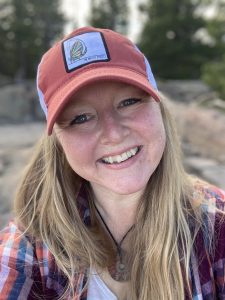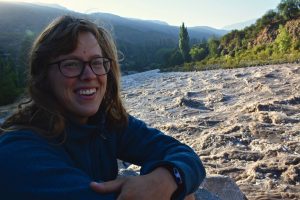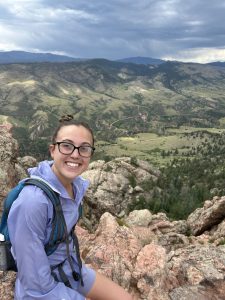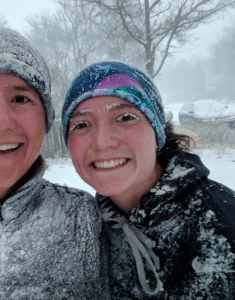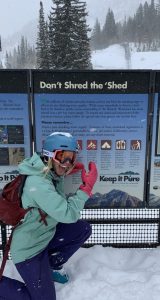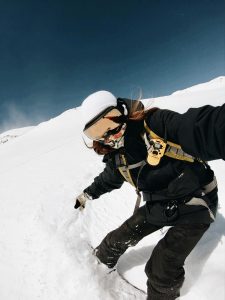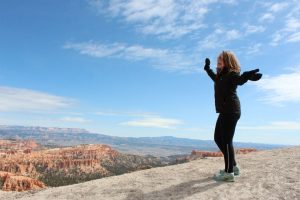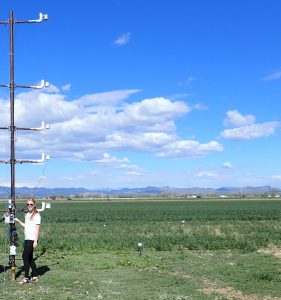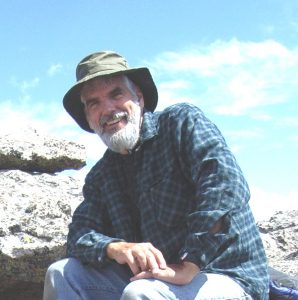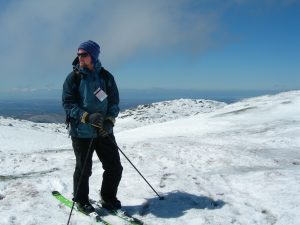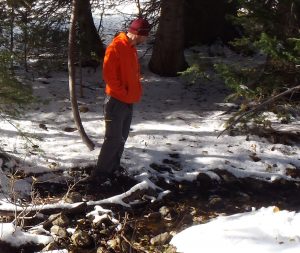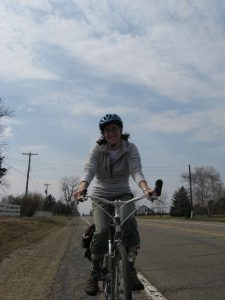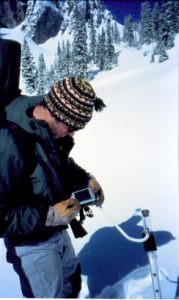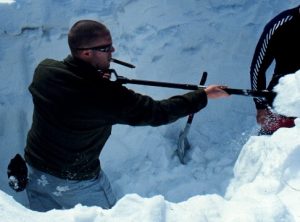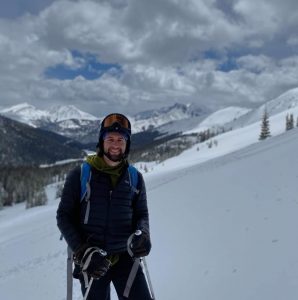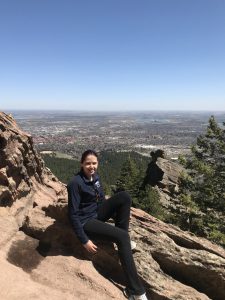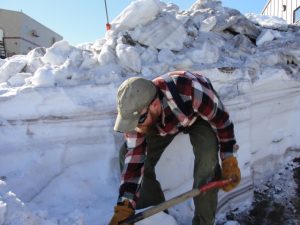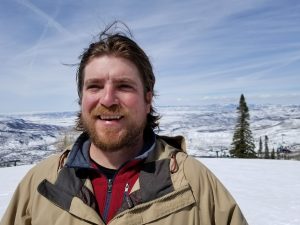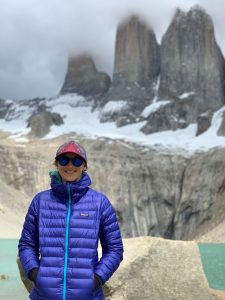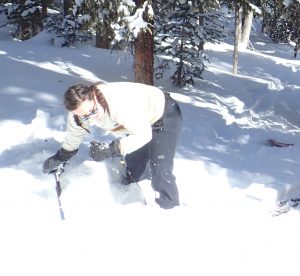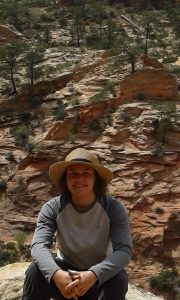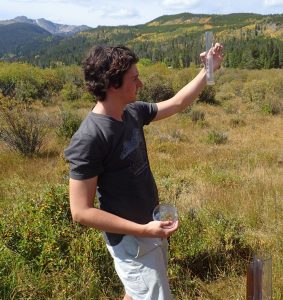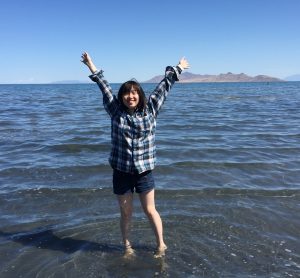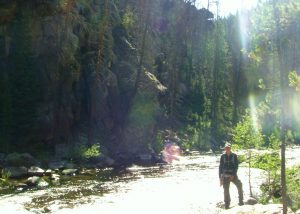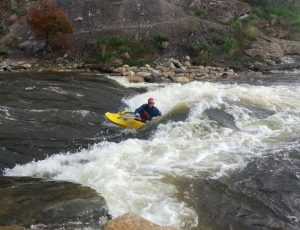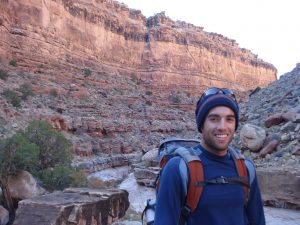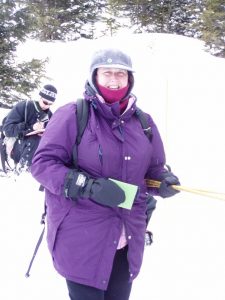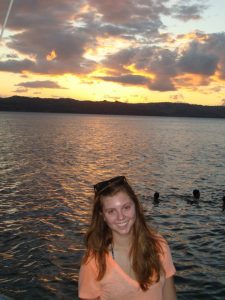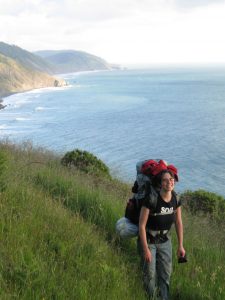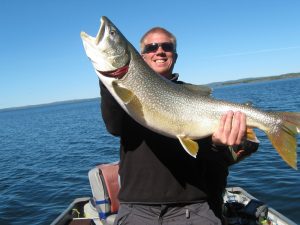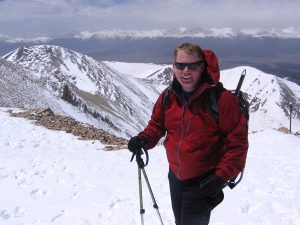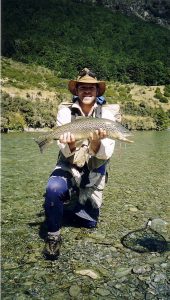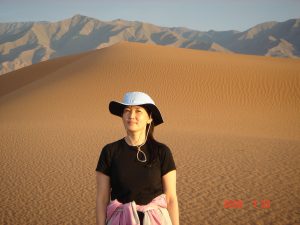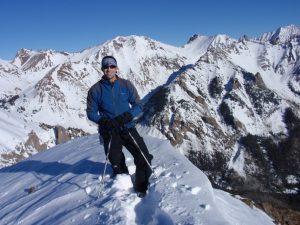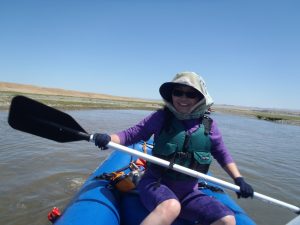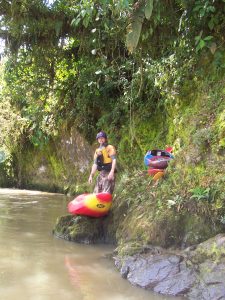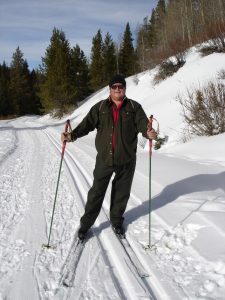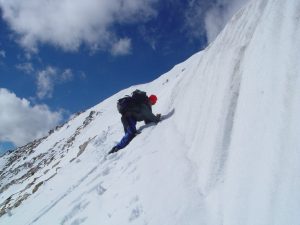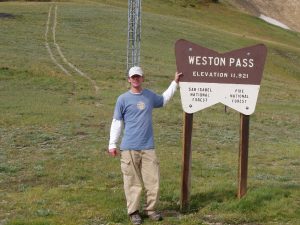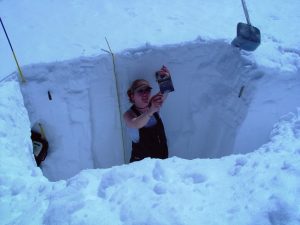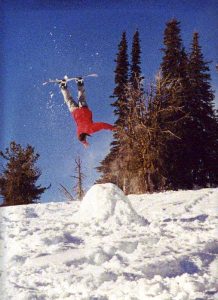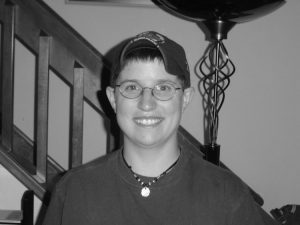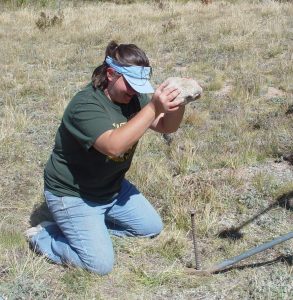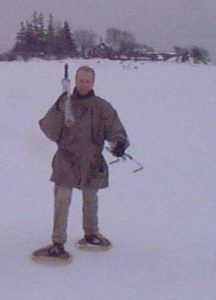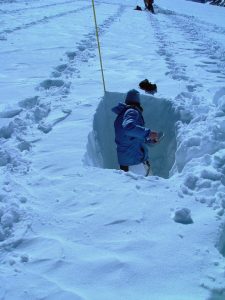CURRENT Ph.D. STUDENTS
Shefa Al Mansour, M.A.
Education:
Ph.D. (Ecosystem Sustainability) in progress Colorado State University, Fort Collins, CO, USA 80523-1476
M.A. Education 2015, California State University, San Bernardino, CA, USA 92407
B.S. Chemistry 2007, Najran University, Najran, Saudia Arabia 46131
research area: Water Resources Sustainability
Ph.D. Committee:
Advisor: Steven Fassnacht
Stephanie Kampf (Watershed Science)
Stacy Lynn (NREL)
Rosa Martey (Journalism & Media Communication)
Alicia F. Tyson, M.S., M.A.
Education:
Ph.D. (Watershed Science) in progress Colorado State University, Fort Collins, CO, USA 80523-1476
M.S. Geographic Information Science and Cartography 2013, University of Denver, Denver, CO 80210
M.A. Broadcast Journalism 2002, University of Colorado Boulder, Boulder, CO 80309
B.A. Communications/Spanish 1999, The University of Alabama in Huntsville, Huntsville, AL 35899
research area: Post-Hurricane Landscape and Social Vulnerabilities Assessment for Improved Risk-Informed Watershed Management through Team Science
Ph.D. Committee:
Advisor: Steven Fassnacht
co-advisor: Camille Stevens-Rumann (FRS)
Andrea Baudoin Farah (ESS)
Neil Grigg (Civil Engineering)
CURRENT M.S. STUDENTS
Elayna (Ella) R. Bump, B.A.
Education:
M.S. (Watershed Science) in progress, Colorado State University, Fort Collins, CO, USA 80523-1476
B.A. (Geography and Environmental Studies) 2015 University of Colorado, Colorado Springs, Colorado 80918
research area: Historical Hydroclimatology in the Southwestern US
M.S. Committee:
Advisor: Steven Fassnacht
Stephanie Kampf (Watershed Science)
Greg Butters (Soil and Crop Sciences)
Christina C. Chow, B.S.
Education:
M.S. (Civil Engineering) in progress, Colorado State University, Fort Collins, CO, USA 80523
B.S. (Environmental Engineering) 2024 University of Vermont, Burlington, VT 05405
research area: Operational Snow Measurements with a Cosmic Radiation Neutron Rover
M.S. Committee:
Co-Advisors: Jeffrey Niemann (Civil Engineering) and Steven Fassnacht
Jocelyn M. Cramer, B.A.
Education:
M.S. (Watershed Science) in progress, Colorado State University, Fort Collins, CO, USA 80523-1476
B.A. Alaska Pacfic University, Anchorage, Alaska 99508
research area: Forest Management and Snowpack Patterns
M.S. Committee:
Advisor: Steven Fassnacht
Madison T. King, B.A.
M.S. (Watershed Science) in progress, Colorado State University, Fort Collins, CO, USA 80523-1476
B.A. (Anthropology) 2024 Purdue University Fort Wayne, Fort Wayne, IN 46805
research area: Climate Change and Indigenous Water
M.S. Committee:
Advisor: Steven Fassnacht
Alison P. Kingston, B.S.
Education:
M.S. (Watershed Science) in progress Colorado State University, Fort Collins, CO, USA 80523-1476
B.A. Geoscience 2018, Hamilton College, Clinton, NY 13323
research area: Snow Recreation in the Present
M.S. Committee:
Advisor: Steven Fassnacht
Molly Tedesche (CRREL)
Tamee Albrecht (Watershed Science)
Sunshine Swetnam (Human Dimensions of Natural Resources)
Marin S. MacDonald, B.S.
M.S. (Watershed Science) in progress, Colorado State University, Fort Collins, CO, USA 80523-1476
B.S. (Watershed Science) 2023, Colorado State University, Fort Collins, CO, USA 80523-1476
research area: Fire and Snow
M.S. Committee:
Advisor: Steven Fassnacht
Molly Tedesche (USACE-CRREL)
Daniel McGrath (Geosciences)
Maisy Weiss, B.A.
Education:
M.S. (Watershed Science) in progress, Colorado State University, Fort Collins, CO, USA 80523-1476
B.A. (Geography) 2020, University of Colorado at Boulder, Boulder, Colorado 80309
B.A. (Ecology & Evolutionary Biology) 2020, University of Colorado at Boulder, Boulder, Colorado 80309
research area: to be determined
M.S. Committee:
Advisor: Steven Fassnacht
David Barnard (USDA-ARS)
Michael Ronanyne (Geosciences)
FORMER Ph.D. STUDENTS
Anna K.D. Pfohl, Ph.D.
Education:
Ph.D. (Watershed Science) 2023, Colorado State University, Fort Collins, CO, USA 80523-1482
M.S. (ESS-Watershed Science) 2016, Colorado State University, Fort Collins, CO, USA 80523-1476
B.S. (Geosciences) 2013 Pacific Lutheran University, Tacoma, Washington 98447
B.A. (Environmental Studies) 2013 Pacific Lutheran University, Tacoma, Washington 98447
Pfohl, A.K.D., 2023. Recent and Future Colorado Water: Snow Drought, Streamflow, and Winter Recreation. Unpublished Ph.D. dissertation, Watershed Science, Colorado State University, Fort Collins, Colorado, USA.
Ph.D. Dissertation Abstract:
Water in the western United States is a crucial resource for ecosystems, the abiotic environment, and people (for industrial, agricultural, and residential purposes). A majority of this water originates in the seasonal snowpack in the mountains. The snowpack is responsible for maintaining the water supply, and changes to this system have broad and severe implications. Various metrics have been used to quantify these patterns when snow is less than normal, often referred to as a snow drought or a low snow year. In recent decades, the number of years with low snow have increased, and this will continue and intensify into the future. With observed decreases in long-term snow and modeled decreases for the future, high snow years become more critical to support the water supply. Beyond supplying water for downstream use, the seasonal snowpack also sustains the winter recreation industry, which is a large component of many local and state economies.
The Weather Research and Forecasting Model (WRF) is a 4-km mesoscale model that can capture orography and convective processes over complex terrain. WRF includes two time periods: the control (CTL) based on historic conditions and the future under pseudo-global warming (PGW) conditions. This dataset was used to drive SnowModel (WRF-SM) to produce 100-m, daily snow water equivalent (SWE), total precipitation, solid precipitation, snowmelt, runoff, and air temperature . Using these datasets, this research examines past and future snow and streamflow in Colorado. We evaluated 1) common metrics and trends for snow drought; 2) used WRF data to drive the Ages hydrologic model to examine changes (snow, streamflow, and flow partitioning) in two high snow years; and 3) ski opportunities at nine different resorts.
To evaluate methods of defining snow drought, we used SWE and winter precipitation data from Snow Telemetry stations and the WRF-SM dataset described above. Classifying drought with the ratio of SWE to winter precipitation resulted in drought occurrence for more than 50% of station-years from 1981 to 2020. Using percentiles of long-term peak SWE indicated that occurrence of low or very low years increased from 2001 to 2020 compared with the previous 20 years. Under PGW conditions, elevations between 1800 and 2400 m shifted drought classification towards low or very l ow, with higher elevations (3200 m and above) remaining relatively unchanged.
To examine changes in snow, streamflow, and flow partitioning under a PGW scenario for two high snow years (2008 and 2011), we used Ages, a spatially distributed watershed model, in the Upper Blue River watershed in central Colorado. Changes in snow (snowmelt and solid precipitation) were greatest in magnitude at high elevations. Timing of peak streamflow shifted to nearly two months earlier under a PGW scenario.
To examine ski opportunities, we developed metrics to quantify ski conditions. The number of opportunities for snowmaking in the future will decrease throughout the season, but especially in October and November. Ski days (snow depth greater than 50 cm) will decrease in early and late season and increase at lower elevations from January through March. Powder days (fresh depth greater than 15 cm and fresh density greater than 125 kg/m3) follow a similar pattern. Ski resorts at low elevations will generally be more susceptible to changes under a PGW scenario. Additionally, using a fine-resolution dataset allowed investigation of smaller study areas to understand the changes that are not captured with coarser resolutions.
Ph.D. Committee:
Advisor: Steven Fassnacht
Stephanie Kampf (Watershed Science)
David Barnard (USDA ARS)
Kristen Rasmussen (Atmospheric Science)
M.S. degree
Pfohl, A.K.D., 2016. Trends in Snowmelt Contribution to Streamflow in the Southern Rocky Mountains of Colorado. Unpublished M.S. thesis, Watershed Science, Colorado State University, Fort Collins, Colorado, USA, 47pp.
M.S. Thesis Abstract
Snowmelt contribution to streamflow in snow-dominated watersheds has largely been limited to using the Center of Volume method, which looks at the day at which a certain amount of flow has passed, typically 20%, 50%, and 80%, referred to as tQ20, tQ50, and tQ80, respectively. We developed a new method to measure streamflow timing in the Southern Rocky Mountains of Colorado for 39 gauging stations from 1976 to 2015. We first manually extracted start and end days from the annual hydrograph of a small, medium, and large watershed to use as “truth.” We then looked at the cumulative annual hydrograph and then found average spring and late fall baseflow. Using these average baseflows, we plotted the cumulative baseflow against the cumulative hydrograph and determined that the start and end of snowmelt contribution, tstart and tend, occurred when the cumulative hydrograph departed from the cumulative baseflow by a given baseflow factor. Using NSE and RMSE values, we determined that 10x and 17.5 baseflow were able to best represent the manually extracted values. NSE values ranged from 0.59 to 0.6 and 0.53 to 0.69 for tstart and tend, respectively; RMSE values ranged from 5.42 to 7.7 and 6.32 to 8.00, for tstart and tend, respectively. In comparison, NSE values ranged from -4.73 to -25.35 and -5.87 to -13.25 for tQ20 and tQ80, respectively; RMSE values ranged from 29.33 to 43.19 and 33.01 to 34.94 for tQ20 and tQ80, respectively. This new automated method was able to better predict values of start and end than what has been commonly used in the literature.
We identified other variables related to snowmelt timing to streamflow, including the percent of flow and volume at the estimated tstart and tend, as well as the total duration of contribution. We used the correlation coefficient to help explain the variance in the observed trends of the different snowmelt timing variables, using different physiographic characteristics (mean slope, mean elevation, mean solar radiation, latitude, and longitude) as well as trends in winter precipitation and summer NDVI. Most of these trends were not statistically significant, but mean slope was best able to explain the variance in trends for tend, Q100, Qend, Qduration, %Qtend, and tQ80 (p < 0.05).
M.S. Committee:
Advisor: Steven Fassnacht
John Stednick (Watershed Science)
Jeffrey Niemann (Civil Engineering)
Jessica E. Sanow, Ph.D.
Education:
Ph.D. (Watershed Science) 2022, Colorado State University, Fort Collins, CO, USA 80523-1482
M.S. (Natural Resources, Environmental Education Certificate) 2016, University of Idaho, Moscow, ID 83844
B.Sc. (Geoscience Hydrology, Minors: GIS and Applied Mathematics) 2014, Boise State University, Boise, ID 83725
Sanow, J.E., 2022. The Dynamic Nature of Snow Surface Roughness. Unpublished Ph.D. dissertation, Watershed Science, Colorado State University, Fort Collins, Colorado, USA.
Ph.D. Dissertation Abstract:
Throughout the winter season, the snowpack becomes the surface-atmosphere boundary for the energy balance within the hydrologic cycle and is key for understanding and modeling meltwater availability, streamflow, and groundwater recharge. The aerodynamic roughness length, z0, is one metric to quantify the roughness characteristics of the snowpack surface. Roughness is a key component when analyzing the snowpack surface energy exchange because it exerts a strong influence on turbulent energy exchanges between the snowpack and atmosphere. Snow surface roughness fluctuates throughout the winter season due to snowpack accumulation and melt, redistribution, ecological, and meteorological influences. However, current hydrologic and energy balance models use a static z0 value despite the snowpack surface, and resulting z0 value, being spatially and temporally dynamic throughout the winter. Inclusion of a site specific, spatially, and temporally variable z0 is expected to improve hydrologic and energy balance models. Therefore, the following research investigates 1) comparing the anemometric and geometric methods of measuring z0, 2) the correlation between z0 and snow depth, 3) spatial and temporal variability of z0, 4) post-processing effects on z0 measurements, and 5) application of a variable z0 within the SNOWPACK model.
Results of this study indicate a strong correlation when comparing geometric versus anemometrical methods of calculation. Thirty wind profiles were compared to 30 corresponding geometrically calculated surface measurements using a terrestrial based LiDAR. These combined profiles had a Nash-Sutcliffe Coefficient of Efficiency of 0.75, an r2 of 0.96, a best fit slope of 0.98, and a Root Mean Square Error of 8.9 millimeters. The correlation between snow depth and z0 is variable depending on periods of melt, accumulation, and the initial snow-free roughness. The z0 was shown to be spatially and temporally variable across study sites. Interpolation resolution during post processing of z0 was found to modify z0 by several orders of magnitude. Variable z0 values were found to alter SNOWPACK model results within several of the output variables. The most sensitive output variables were sublimation, latent, and sensible heat due to the direct use of z0 within the calculations. These key findings highlight the importance of a variable z0. Inclusion of a variable z0 parameterization within models should be site specific, spatially and temporally dynamic, with special attention to post-processing steps.
Ph.D. Committee:
Advisor: Steven Fassnacht
Dan McGrath (Geoscience)
Graham Sexstone (USGS)
William Bauerle (Horticulture)
Molly E. Tedesche, Ph.D.
Education:
Ph.D. (Water & Environment, International Arctic Research Center) 2021 University of Alaska Fairbanks, Fairbanks, AK 99775
M.S. (Watershed Science) 2010 Colorado State University, Fort Collins, CO, USA 80523-1472
B.S. (Civil Engineering Technology – Environmental Science) 2004 Rochester Institute of Technology, Rochester, NY 14623
Tedesche, M.E., 2021. Brooks Range Perennial Snowfields: Mapping and Modeling Change in Alaska’s Cryosphere. Unpublished Ph.D. dissertation, University of Alaska, Fairbanks, Alaska, USA.
Ph.D. Dissertation Abstract:
Perennial snowfields, such as those found in the Brooks Range of Alaska, are a critical component of the cryosphere. They serve as habitat for an array of wildlife, some of which are crucial for rural subsistence hunters. Snowfields also influence hydrology, vegetation, permafrost, and have the potential to preserve valuable archaeological artifacts. In this study, perennial snowfield extents in the Brooks Range are derived from satellite remote sensing, field acquired data, and snow melt modeling. The remote sensing data are used to map and quantify snow covered area changes across multiple temporal scales, spatial resolutions, and geographic sub-domains.
Perennial snowfield classification techniques were developed using optical multi-spectral imagery from NASA Landsat and European Space Agency Sentinel-2 satellites. A Synthetic Aperture Radar change detection algorithm was also developed to quantify snow covered area using Sentinel-1 data. Results of the remote sensing analyses were compared to helicopter and manually collected field data. Also, a snowfield melt model was developed using an adaptation of the temperature index method to determine probability of melt via binomial logistic regression in two dimensions. The logistic temperature melt model considers summer season snow covered area changes per pixel in remotely sensed products and correlationships withto several independent variables, including elevation-lapse-adjusted air temperature and terrain-adjusted solar radiation.
Evaluations of the Synthetic Aperture Radar change detection algorithm via comparison with results from optical imagery analysis, as well as via comparison with field acquired data, indicate that the radar algorithm performs best in small, focused geographic sub-domains. The multi-spectral approach appears to perform similarly well within multiple geographic domain sizes. This may be the result of synthetic aperture radar algorithm dependency on backscatter thresholding techniques and slope corrections in mountainous complex topography.
Results indicate that perennial snowfield extents in the Brooks Range are decreasing over decadal time scales, with short-lived, interannual and seasonal increases. Results also show that perennial snowfields are more persistent at higher elevations over time with notable consistency in at least one of the Brooks Range sub-domains of this study, Gates of the Arctic National Park and Preserve. Climate change may be altering the distribution, elevation, melt behavior, and overall extents of the Brooks Range perennial snowfields. Such changes could have significant implications for hydrology, wildlife, vegetation, and subsistence hunting in rural Alaska.
Ph.D. Committee:
Advisor: Steven Fassnacht
Coadvisor: David Barnes (Civil Engineering UAF)
Erin Trochim (AK CASC, SNAP, IARC)
Gabriel Wolken (Alaska Climate Adaptation Science Center)
M.S. degree
Tedesche, M.E., 2010. Snow Depth Variability in Sagebrush Drifts in High Altitude Rangelands, North Park, Colorado. Unpublished M.S. thesis, Watershed Science, Colorado State University, Fort Collins, Colorado, USA, 82pp.
M.S. Thesis Abstract
In high altitude rangelands, such as those in Colorado, sagebrush and other shrubs can affect transport and deposition of wind-blown snow, thus enabling the formation of snowdrifts. Sagebrush management techniques could have significant effects on snow accumulation patterns. Snow that potentially could have been trapped by the plants may return to the atmosphere through sublimation. Soil moisture and subsequent plant growth may be affected by this sublimation. Measurement of snow depth and the spatial variability of these measurements might be important information for understanding snowdrift formation processes. Determination of the most effective measurement scale for understanding important ecologic and hydrologic processes in this environment is therefore essential. Directional variogram analyses and Moran’s I statistics are two efficient methods for representing the spatial variability of snow depth at different measurement scales in shallow rangeland snow packs.
The three following hypotheses are tested to determine the nature of snow depth spatial variability in the high altitude plateau rangeland of North Park, Colorado, using directional variogram analyses and Moran’s I statistical methods: (1) Sagebrush plant dimensions (microtopography) are less spatially autocorrelated than the variations in snow depth measurements in resultant snowdrifts around an individual plant; (2) As winter progresses and the voids within sagebrush plants are filled with wind-distributed snow, the resultant surface evolves into a progressively less spatially variable microtopography; (3) When measuring a shallow rangeland snow pack, smaller scale measurements produce a progressively more spatially variable dataset of snow depths and a therefore less spatially autocorrelated snow surface texture.
Results of both the variogram and Moran’s I analyses indicate that the first hypothesis may be supported. Variogram gamma values and fractal dimensions for the sagebrush canopy microtopography tend to be larger than for the corresponding snow depth measurements. This specifies more spatial variability in the sagebrush surface than in snow depths. The Moran’s I values also indicate that there is less spatial autocorrelation within sagebrush plant geometry than there is among snow depth measurements in resultant snowdrifts.
The second hypothesis is also supported by the results of both variogram analyses and Moran’s I statistics. Variogram analyses indicate that snow depth becomes less spatially variable (with lower sill values) as the winter progresses. There is also evidence of a “leveling-off” of the spatial variability occurring later in the season. Variogram coefficients of variation and fractal dimensions are also very close in value. The Moran’s I values also indicate more positive spatial autocorrelation among snow depths throughout the winter season.
Results of the variogram analyses for the multiple scale snow depth datasets do not support the third hypothesis. The results actually indicate that smaller scale snow depth measurements produce a more spatially autocorrelated dataset in shallow rangeland snow packs. As scale in snow depth measurements increases, both lag distances and gamma values increase slightly, as well. The Moran’s I values are more supportive of the third hypothesis, indicating that mid-range small-scale snow depth measurements may be the least spatially variable.
Committee:
Advisor: Steven Fassnacht
Paul Meiman (Range Science)
Alan Knapp (Biology)
Douglas M. Hultstrand, Ph.D.
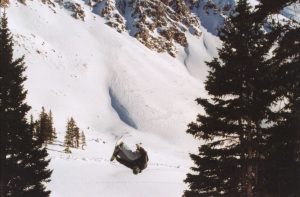
Education:
Ph.D. (Watershed Science) 2021 Colorado State University, Fort Collins, CO, USA 80523-1482
M.S. (Watershed Science) 2006 Colorado State University, Fort Collins, CO, USA 80523-1472
B.A. (Geography) 2003 University of Colorado at Boulder, Boulder, Colorado 80309
Hultstrand, D.M., 2021. Uncertainty in Hydrological Estimation. Unpublished Ph.D. dissertation, Watershed Science, Colorado State University, Fort Collins, Colorado, USA.
Ph.D. Dissertation Abstract:
Detailed hydrometeorologic analyses and uncertainty assessments are needed to aid water resources decision-making, to account for upstream-downstream linkages and dominant process scale for integrated land and water resources management and planning. The water balance is a fundamental concept in hydrology that inspires many tools for predicting the specific components including precipitation, streamflow, soil moisture, and groundwater storage. A water balance is typically expressed as an equation that relates water inputs, outputs, and storage of a system. The water balance model is applied to analyze the allocation of water among components of the hydrologic system. Knowledge on the components composing inputs and outputs in a water balance are essential to understanding watershed processes. While methods to measure and model water balance components continue to improve, all components of the balance have substantial uncertainty.
Methods to analyze a water balance should acknowledge these uncertainties and consider how they propagate through water balance calculations in order to better assist water resources decisions. This research investigated four water balance components: (1) snowpack sublimation, (2) precipitation as snow, (3) precipitation as rain, and (4) stream discharge in mountainous watersheds in order to examine and build our knowledge of uncertainty in the water balance for mountainous environments. The research presented in this dissertation supports a theme that hydrology is a highly uncertain science, where uncertainty is a result of the hydrologic community’s knowledge gap to accurately model physics of atmospheric and hydrologic processes. A finding of this work is that no component of the water balance can be quantified at watershed scale without estimating he associated uncertainty. Results highlight that mean cumulative snowpack sublimation uncertainty is 41% with individual input variable uncertainties in the range of 1 to 29%; simulated to observed basin mean snow depth was estimated within 15% for 10-years while extreme dry and wet years were within 5%; and forcing precipitation datasets used in hydrologic models to estimate streamflow have cumulative uncertainties in the range of 30 to 60%. Results of this dissertation identify the importance to account for uncertainty in water resources, i.e., Monte Carlo methods, to properly account for and quantify associated risks in water management and design infrastructure decisions.
Ph.D. Committee:
Advisor: Steven Fassnacht
Melinda Laituri (Watershed Science)
Christopher Hiemstra (CRREL)
John Stednick (Watershed Science)
M.S. degree
Hultstrand, D.M., 2006. Geostatistical Methods for Estimating Snowmelt Contribution to the Annual Water Balance in an Alpine Watershed. Unpublished M.S. thesis, Watershed Science, Colorado State University, Fort Collins, Colorado, USA, 104pp + 1appendix.
M.S. Thesis Abstract:
Spatial interpolation methods can provide accurate estimates of distributed snow water equivalent (SWE) when intensive snow depth and density observations are available. In this study, the performance of nine spatial interpolation models was evaluated to estimate snowmelt contributions to streamflow into an alpine watershed. In April 2005, peak accumulation snow depth and snow density measurements were collected over the West Glacier Lake (WGL) watershed. The distribution of SWE was calculated as the product of snow depth, snow density, and snow-covered area (SCA). Snow depths were spatially distributed throughout the watershed through spatial interpolation methods. Snow densities were spatially distributed through multiple linear regression analysis. The nine spatial snow depth models explained 18% to 94% of the observed variance in the measured snow depths. Co-kriging with solar radiation produced the best results explaining 94% of the observed variance in snow depth measurements. The annual water balance, expressed as equivalent water depths was total precipitation (1,481 mm), snowpack sublimation (251 mm), and streamflow (1,000 mm), resulting in an estimate of evapotranspiration (230 mm). Estimated SWE from the field survey data was 67% greater than precipitation gauge estimates and accounted for 85% of the annual streamflow.
M.S. Committee:
Advisor: Steven Fassnacht
Co-Advisor: John Stednick (Watershed Science)
Bob Musselman (USFS RMRS)
Nolan Doesken (CIRA)
Glenn G. Patterson, Ph.D.
Education:
Ph.D. (Watershed Science) 2016 Colorado State University, Fort Collins, CO, USA 80523-1482
M.S. (Watershed Management), University of Arizona
B.A. (Biology), University of Chicago
Patterson, G.G., 2016. Trends in snow water equivalent in Rocky Mountain National Park and the northern Front Range of Colorado, USA. Unpublished Ph.D. dissertation, Watershed Science, Colorado State University, Fort Collins, Colorado, USA.
Ph.D. Dissertation Abstract:
The seasonal snowpack in Rocky Mountain National Park and the northern Front Range of Colorado, USA, within 50 km of the park, is undergoing changes that will pose challenges for water providers, natural resource managers, and winter recreation enthusiasts. Assessing long-term temporal trends in measures of the seasonal snowpack, and in the climatic factors that influence its annual accumulation and ablation, helps to characterize those challenges. In particular, evaluating the patterns of variation in those trends over different parts of the snow season provides new understanding as to their causes. This also helps to determine specific ramifications of the trends. In addition, placing the current 35-year trends in the longer context of longer-term observational records, and paleoclimate tree-ring reconstructions, provides useful comparisons of current and past trends. Finally, projections of future trends provided by linked climate and hydrologic models offer a sense of how these trends are likely to affect the snowpack of the future. Some factors such as the high elevation of the study area help to preserve conditions favorable to development of the seasonal snowpack, and hence to limit trends toward greater warming-induced melt and less precipitation falling as snow. Nevertheless, traditional snowpack measures such as April 1 snow water equivalent (SWE) show consistent declining trends over the 35-year period of record for automated snow monitoring stations in the study area. The trends are not uniform throughout the snow season, but vary significantly by month. As a result, November and March have warming and drying trends that delay the beginning of the winter snow season and reduce the traditional accumulation that formerly characterized the early spring. In contrast, the core winter months of December, January, and February have cooling and wetting trends that have been enhancing SWE during the heart of the winter. Mid-April to early May is another period during which cooling and wetting trends have been enhancing SWE, although these months also show more variability. This oscillating pattern helps to explain why there has not been a pervasive shift to earlier and lower annual peak SWE in the study area. Paleo SWE reconstructions based on tree-ring chronologies show that at least some of the recent 35-year trends in observed SWE described in this study have comparable precedents during the preceding five centuries, but we do not yet know how long the recent trends will continue. Linked climate and hydrologic models project that the observed trends are likely to continue, and that by 2050 measures such as April 1 SWE in the study area are likely to decrease by 25 percent.
Ph.D. Committee:
Advisor: Steven R. Fassnacht
Melinda Laituri (Watershed Science)
William Sanford (Geosciences)
James Pritchett (Agriculture and Resource Economics)
Graham A. Sexstone, Ph.D.
Education:
Ph.D. (Watershed Science) 2016 Colorado State University, Fort Collins, CO, USA 80523-1482
M.S. (Watershed Science) 2012 Colorado State University, Fort Collins, CO, USA 80523-1476
B.A. (Geography) 2007, University of Vermont , Burlington, Vermont 05405
Sexstone, G.A., 2016. Snow Sublimation and Seasonal Snowpack Variability. Unpublished Ph.D. dissertation, Watershed Science, Colorado State University, Fort Collins, Colorado, USA.
Ph.D. Dissertation Abstract:
In the western United States, seasonal melt from snow in mountainous regions serves as an essential water resource for ecological and anthropological needs, and improving our abilities to quantify the amount of water stored in the seasonal snowpack and provide short-term forecasts of snowmelt inputs into river systems is a critical science endeavor. Two important uncertainties in characterizing the seasonal evolution of snow in mountainous environments are related to the inherent spatial variability of snow in complex terrain and the magnitude and variability of snow sublimation fluxes between snow and the atmosphere; these uncertainties motivate this collection of research which includes three studies conducted in the north-central Colorado Rocky Mountains. The first study uses fine resolution airborne lidar snow depth datasets to evaluate the spatial variability of snow within areas comparable to coarse scale model grids (i.e. subgrid variability). Snow depth coefficient of variation, which was used as a metric for evaluating subgrid snow variability, exhibited substantial variability in mountainous terrain and was well correlated with mean snow depth, land cover type, as well as canopy and terrain characteristics. Results highlight that simple statistical models for predicting subgrid snow depth coefficient of variation in alpine and subalpine areas can provide useful parameterizations of subgrid snow distributions. Given that snow sublimation fluxes are expected to exert important influences on snow distributions, the second and third studies focus on measuring and modeling the variability and importance of snow sublimation. To evaluate the relative merits and measurement uncertainty of methods for quantifying snow sublimation in mountainous environments, a comparison was made between the eddy covariance, Bowen ratio-energy balance, bulk aerodynamic flux, and aerodynamic profile methods within two forested openings. Biases between methods are evaluated over a range of environmental conditions, which highlight limitations and uncertainties of each method. Results highlight the challenges and importance related to measuring surface sublimation in snow-covered regions, and provide guidance for future investigations seeking to quantify snow sublimation through station measurements. To evaluate the spatial variability and importance of snow sublimation, a process-based snow model is applied across a 3600 km2 domain over five water years. In-situ eddy covariance observations of snow sublimation compare well with modeled snow sublimation at sites dominated by surface and canopy sublimation, but highlight challenges with model evaluation at sites were blowing sublimation is prominent. Modeled snow sublimation shows considerable spatial variability at the hillslope scale that is evident across elevation gradients and between land cover types. Snow sublimation from forested areas (canopy plus surface sublimation) accounted for the majority of modeled sublimation losses across the study domain and highlights the importance of sublimation from snow stored in the forest canopy in this region. Results from this study suggest that snow sublimation is a significant component of the winter water balance and strongly influences snow distributions in this region, and have important implications for future water management and decision making.
Ph.D. Committee:
Advisor: Steven R. Fassnacht
David W. Clow (USGS)
Christopher A. Hiemstra (USACE-CRREL)
Gregory L. Butters (Soil and Crop Sciences)
M.S. degree
Sexstone, G.A., 2012. Evaluating the Spatial Variability of Snowpack Properties Across a Northern Colorado Basin. Unpublished M.S. thesis, Watershed Science, Colorado State University, Fort Collins, Colorado, USA, 97pp + 3 appendices (129pp total).
M.S. Thesis Abstract:
Knowledge of seasonal mountain snowpack distribution and estimates of its snow water equivalent (SWE) can provide insight for water resources forecasting and earth system process understanding, thus, it is important to improve our ability to describe the spatial variability of SWE at the basin scale. The objectives of this thesis are to: (1) develop a reliable method of estimating SWE from snow depth for the Cache la Poudre basin, and (2) characterize the spatial variability of SWE at the basin scale within the Cache la Poudre basin. A combination of field and Natural Resource Conservation Service (NRCS) operational-based snow measurements were used in this study. Historic (1936 – 2010) snow course data were obtained for the study area to evaluate snow density. A multiple linear regression model (based on the historical snow course data) for estimating snow density across the study area was developed to estimate SWE directly from snow depth measurements. To investigate the spatial variability and observable patterns of SWE at the basin scale, snow surveys were completed on or about April 1, 2011 and 2012 and combined with NRCS operational measurements. Bivariate relations and multiple linear regression models were developed to understand the relation of SWE with physiographic variables derived using a geographic information system (GIS). SWE was interpolated across the Cache la Poudre basin on a pixel by pixel basis using the model equations and masked to observed SCA (from an 8-day MODIS product).
The independent variables of snow depth, day of year, elevation, and UTM Easting were used in the model to estimate snow density. Calculation of SWE directly from snow depth measurement using the snow density model has strong statistical performance and model verification suggests the model is transferable to independent data within the bounds of the original dataset. This pathway of estimating SWE directly from snow depth measurement is useful when evaluating snowpack properties at the basin scale, where many time consuming measurements of SWE are often not feasible. Bivariate relations of SWE and snow depth measurements (from WY 2011 and WY 2012) with physiographic variables show that elevation and location (UTM Easting and UTM Northing) are most strongly correlated with SWE and snow depth. Multiple linear regression models developed for WY 2011 and WY 2012 include elevation and location as independent variables and also include others (e.g., eastness, slope, solar radiation, curvature, canopy density) depending on the model dataset. The final interpolated SWE surfaces, masked to observed SCA, generally show similar patterns across space despite differences in the 2011 and 2012 snow years and differing estimation of SWE magnitude between the combined dataset of field-based and operational-based measurements (modelO+F) and the dataset of operational-based measurements only (modelO). Within each of the model surfaces, interpolated volume of SWE was greatest within Elevation Zone 5 (3,043 – 3,405 m). The percentage of the total interpolated SWE volume for each model was distributed similarly among elevation zones.
M.S. Committee:
Advisor: Steven Fassnacht
Melinda Laituri (Watershed Science)
Jason Sibold (Anthropology)
Ryan W. Webb, Ph.D.
Education:
Ph.D. (Civil and Environmental Engineering – Hydrologic Science and Engineering) 2016, Colorado State University, Fort Collins, Colorado, 80523 USA
M.S. (Civil Engineering – Hydrology and; Water Resources) 2012, University of New Mexico, Albuquerque, NM 87131
B.S. (Construction Engineering) 2010, University of New Mexico, Albuquerque, NM 87131
Webb, R.W., 2016. Fate of Snowmelt in Complex Subalpine Terrain. Unpublished Ph.D. dissertation, Civil and Environmental Engineering, Colorado State University, Fort Collins, Colorado, USA
Ph.D. Dissertation Abstract:
Snow is important to human communities and natural ecosystems around the world that rely on snowmelt runoff for as much as 80% or more of streamflow. In addition to streamflow, snowmelt can drive hydrological processes such as groundwater recharge, soil moisture dynamics, forest ecosystem dynamics, and potentially cause high damage flooding. Multiple environmental controls will cause snow to vary in depth, density, and snow crystal metamorphism causing a complex three dimensional matrix of ice, air, water vapor, and liquid water (during melt) that is non-uniform across a landscape and varies in time at the daily and even hourly scale. Because of the non-uniform dynamics of snow and snowmelt processes, multi-dimensional studies are necessary to determine hydrological flow paths during spring snowmelt. The goal of this dissertation is to investigate the physical processes that control the fate of snowmelt during spring runoff in complex subalpine terrain. These processes were investigated through 1) observing the diurnal pattern of snowmelt in Colorado’s Front Range, 2) testing the diversion potential of hydraulic barriers within a layered snowpack through numerical modeling, 3) collecting field data to investigate the spatio-temporal patterns of water distribution during spring snowmelt, and 4) analyzing a network of soil moisture sensors in California’s Southern Sierra Nevada to determine the variability of infiltration in a headwater catchment. Observations of the diurnal temporal pattern of snowmelt resulted in a relatively simple method to capture the outflow from a snowpack using hourly snow water equivalent data. The resulting temporal pattern is comparable to design rainfall distribution types specifically for snowmelt that can be important for flood risk analysis or design of channels in previously unmonitored headwater systems. The observed temporal patterns were also used to inform numerical simulations in the modeling package TOUGH2 that utilized additional data from NASA CLPX datasets to simulate meltwater percolation through a melting snowpack. Results of this component of the dissertation displays the potential for hydraulic barriers to form on south, flat, and north aspect hillslopes and potentially divert downward flowing water at similar scales as the topographic or land cover variability. Hydraulic barriers in simulations were permeability barriers only on the south and flat aspect slopes and capillary barriers only on the north aspect slopes. The dynamic nature of a snowpack in the presence of water implies that the capillary barriers are likely short-lived relative to permeability barriers and thus capillary barriers may be important at the day or week timescale and permeability barriers may be more influential at the monthly or seasonal time scale. Field observations near Steamboat Springs, Colorado were made for above normal, relatively normal, and below normal snow seasons including measurements of bulk snow water equivalent and soil moisture on varying slope, aspect, soil parameters, and canopy conditions with results displaying the variability from these influences. Evidence was present of meltwater flowing above the soil surface and through the snowpack. At the base of the north aspect slope the water table rose above the soil surface and the snowpack added storage capacity to the vadose zone. The variability of snowmelt and resulting soil moisture and infiltration dynamics was supported by the analysis of a network of soil moisture sensors in California’s Southern Sierra Nevada. This component of the dissertations displayed the high variability of wetting and drying dynamics beneath a snowpack at the sub-hillslope and watershed scale. Results of this dissertation display that the snowpack acts as an extension of the vadose zone during spring snowmelt and that one-dimensional assumptions are not appropriate in headwater catchments during this time. Consideration of the snowpack and soil together will improve modeling, remote sensing, and water balance calculations for hydrologic studies during spring snowmelt and improvements upon allocation of streamflow, groundwater recharge, and evapotranspiration.
Ph.D. Committee:
Advisor: Michael Gooseff (Civil & Environmental Engineering)
Co-Advisor: Steven R. Fassnacht
Jorge Ramirez (Civil & Environmental Engineering)
Jeffrey Niemann (Civil & Environmental Engineering)
Niah B.H. Venable, Ph.D.
Education:
Ph.D. (Watershed Science) 2016, Colorado State University, Fort Collins, Colorado 80523-1482, USA
M.S. (Earth Science, Hydrogeology emphasis) 2006, Western Michigan University , Kalamazoo, MI 49008
B.S. (Forestry, Geology minor) 1997, Oklahoma State University , Stillwater, OK 74078
Venable, N.B.H., 2016. Trends and Tree-rings: An Investigation of the Historical and Paleo Proxy Hydroclimate Record of the Khangai Mountain Region of Mongolia. Unpublished Ph.D. dissertation, Watershed Science, Colorado State University, Fort Collins, Colorado, USA, 168pp + 4 appendix (419pages total).
Ph.D. Dissertation Abstract:
The Khangai Mountain region of western central Mongolia is a diverse area of mountain, forest, steppe, and desert steppe landscapes reaching across and beyond the mountains. The tradition of nomadic pastoralism is strong in the region, with water for domestic and livestock needs supplied through lakes, springs, rivers, and wells. Herders of the region have felt impacts from the climatic extremes of the last few decades in terms of increasing temperatures and decreasing water supplies.
The main objective of this dissertation is to quantify the changing climate of Mongolia through analysis of key hydrometeorological variables over space and through time. The assessments of trends in the data and the paleo proxy analyses herein address interdisciplinary research questions using multidisciplinary approaches. In closing, this work also examines how the data and analyses presented are used as objects that cross disciplinary boundaries, and can facilitate communication and collaboration between different groups.
To provide context for this work, a countrywide view of changing maximum temperature, minimum temperature, and precipitation are examined using trend analyses of gridded datasets. Both minimum and maximum temperatures are significantly warming across the country. Significant decreases in precipitation are concentrated in the central and eastern parts of the country for the 50-year period of analysis. Local knowledge of hydroclimatic change provides another source of climatic information with herders of the Khangai Mountain region observing temperature increases, though the exact time period over which change has occurred varies depending upon memory. Therefore, temperature data were analyzed from five meteorological stations with varying lengths of record from 15 to 50 years and varying start periods based on the available length of record. The most highly significant changes occurred for the longest time periods and for annual average minimum temperatures.
Issues of data availability, serial correlation, and homogeneity of climate records were explored using the Mann-Kendall test for trend significance and the Thiel-Sen method for determining trend slope or magnitude in precipitation and streamflow records. An additional step of prewhitening the data prior to testing was used to reduce the influence of autocorrelation on results. Homogeneity testing was also performed. Decreasing trends in annual, spring, and summer precipitation and/or streamflow were found at several Mongolian stations, particularly on the northern side of the mountains, with increasing winter precipitation trends at one site. Results were compared to analyses using Colorado data, and degradation of the Colorado hydroclimate records by shortening the time series and introducing gaps to simulate inconsistencies found in Mongolian datasets created significant trends where none previously existed.
Tree-ring reconstructions of Mongolian hydroclimate variables have provided insight on multidecadal and muticentennial trends in climate variability over many other parts of the country, but that work has not been extended to contextualize the recent sharply decreasing streamflows of the Khangai Mountain region. Cores from two new sites collected in the summer of 2012 and records from eight other moisture-sensitive sites in the region were used to reconstruct streamflow for four gages. Missing streamflow data were filled by multiple imputation/predictive mean matching methods with data from six nearby meteorological stations prior to use in multiple linear regression models developed for the reconstructions. A quantitative evaluation of reconstructed and historical extremes of wet and dry conditions in each basin and qualitative analyses of event synchrony are discussed. The drought events of the last decade and a half, while extreme are not beyond the range of natural variability found over the last 300+ years in the four Khangai Mountain region rivers and could be considered plausible flow conditions for the future, particularly under a warming and possibly drying climate.
Finally, this dissertation explores cross-boundary connections within each previous chapter and contributions of this work to selected goals of the Mongolian Rangelands and Resilience (MOR2) project, an interdisciplinary and cross-cultural collaboration investigating the resilience of Mongolian pastoral systems to climate change. Changes to the livelihoods of traditional nomadic pastoralists of Mongolia are not only attributable to climate, but also represent changes to socio-ecological, economic, and governmental/policy systems. The analyses of observational gridded, station-based, and paleo proxy data in this dissertation provide a quantitative foundation for continued investigations of the physical hydroclimate systems of the region and further themes developed in previous research from across Asia and within Mongolia. The results of this work will prove useful as a foundation for the development of water policy and infrastructure ideally favoring sustainable nomadic pastoral use of the region’s finite water resources under a changing climate.
Ph.D. Committee:
Advisor: Steven R. Fassnacht
Melinda Laituri (Watershed Science)
William Sanford (Geosciences)
Peter Brown (RMTRR)
Jeffrey S. Deems, Ph.D.
Education:
Ph.D. (Watershed Science) 2007, Colorado State University, Fort Collins, Colorado 80523-1482 USA
M.S. (Earth Sciences) 2002, Montana State University, Bozeman, Montana
B.A. (Geology) 1995, University of Colorado at Boulder, Boulder, Colorado
Deems, J.S., 2007. Quantifying Scale Relationships in Snow Distributions. Unpublished Ph.D. dissertation, Watershed Science, Colorado State University, Fort Collins, Colorado, USA. [also see pdf]
Ph.D. Dissertation Abstract:
Spatial distributions of snow in mountain environments represent the time integration of accumulation and ablation processes, and are strongly and dynamically linked to mountain hydrologic, ecologic, and climatic systems. Accurate measurement and modeling of the spatial distribution and variability of the seasonal mountain snowpack at different scales are imperative for water supply and hydropower decision-making, for investigations of land-atmosphere interaction or biogeochemical cycling, and for accurate simulation of earth system processes and feedbacks.
Assessment and prediction of snow distributions in complex terrain are heavily dependent on scale effects, as the pattern and magnitude of variability in snow distributions depends on the scale of observation. Measurement and model scales are usually different from process scales, and thereby introduce a scale bias to the estimate or prediction. To quantify this bias, or to properly design measurement schemes and model applications, the process scale must be known or estimated. Airborne Light Detection And Ranging (lidar) products provide high-resolution, broad-extent altimetry data for terrain and snowpack mapping, and allow an application of variogram fractal analysis techniques to characterize snow depth scaling properties over lag distances from 1 to 1000 meters.
Snow depth patterns as measured by lidar at three Colorado mountain sites exhibit fractal (power law) scaling patterns over two distinct scale ranges, separated by a distinct break at the 15-40 m lag distance, depending on the site. Each fractal range represents a range of separation distances over which snow depth processes remain consistent. The scale break between fractal regions is a characteristic scale at which snow depth process relationships change fundamentally. Similar scale break distances in vegetation topography datasets suggest that the snow depth scale break represents a change in wind redistribution processes from wind/vegetation interactions at small lags to wind/terrain interactions at larger lags. These snow depth scale characteristics are interannually consistent, directly describe the scales of action of snow accumulation, redistribution, and ablation processes, and inform scale considerations for measurement and modeling.
Snow process models are designed to represent processes acting over specific scale ranges. However, since the incorporated processes vary with scale, the model performance cannot be scale-independent. Thus, distributed snow models must represent the appropriate process interactions at each scale in order to produce reasonable simulations of snow depth or snow water equivalent (SWE) variability. By comparing fractal dimensions and scale break lengths of modeled snow depth patterns to those derived from lidar observations, the model process representations can be evaluated and subsequently refined. Snow depth simulations from the SnowModel seasonal snow process model exhibit fractal patterns, and a scale break can be produced by including a sub-model that simulates fine-scale wind drifting patterns. The fractal dimensions provide important spatial scaling information that can inform refinement of process representations. This collection of work provides a new application of methods developed in other geophysical fields for quantifying scale and variability relationships.
Ph.D. Committee:
Advisor: Steven R. Fassnacht
Kelly Elder (USFS-RMRS)
Thomas Painter (NSIDC)
Glen Liston (CIRA)
Kevin A. Dressler, Ph.D.
Education:
Ph.D. (Hydrology and Water Resources) 2005, University of Arizona, Tucson, Arizona, USA 85721
B.S. (Earth Systems) 1999 Pennsylvania State University, University Park, PA 16802
Dressler, K.A., 2005. Estimating the Spatial Distribution of Snow Water Equivalent and Simulated Snowmelt Runoff Modeling in Headwater Basins of the Semi-arid Southwest. Unpublished Ph.D. dissertation, Hydrology and Water Resources, University of Arizona, Tucson, Arizona, USA
Ph.D. Dissertation Abstract:
The spatial distribution of snowpack in relation to snow water equivalent (SWE) and covered extent is highly variable in time both seasonally and interannually. In order to assess basin water resources, SWE must be distributed to areal estimates. This spatially distributed SWE connects the point scale to the larger scale of the basin (i.e. macro-scale), requiring a combination approach of statistical interpolation techniques and snowpack extent constraint from remote sensing. This research connects those multiple spatial scales and applies the combined remote sensing and ground-based SWE products in a hydrologic model setting to aid in improving streamflow forecasting in the mountainous terrain of snowmelt-dominated basins, a current modeling gap. Four specific advancements were achieved: 1) a comprehensive assessment of spatial distribution techniques in interpolating point snow water equivalent (SWE) measurements at snow telemetry (SNOTEL) stations to the macro-scale was made and an optimal technique for distributing SWE on this scale was obtained; 2) differences between two major data sources of SWE (SNOTEL and snowcourse) were quantified for both point-scale variability and interpolated macro-scale variability to determine spatial and temporal differences in data sources for dry, average and wet years to better inform water resources management applications; 3) basin-scale estimates of ground-based SWE and snow covered area (SCA) from remote sensing were evaluated relative to equivalent fields calculated by a hydrologic model and the effect of assimilating the remote sensing products into the model were investigated; and 4) in the context of (3), improvements were made in macro-scale SCA estimates through both a canopy correction and a low pass statistical filter in an effort to correct for the relatively low resolution of remotely sensed estimates.
Ph.D. Committee:
Advisor: Roger C. Bales (HWR Arizona; U Merced)
Co-Advisor: Steven R. Fassnacht
James W. Shuttleworth (HWR Arizona)
Bart M. Nijssen ((HWR Arizona)
FORMER M.S. STUDENTS
Jack J. Reuland, B.S.
Education:
M.S. (Watershed Science) 2025, Colorado State University, Fort Collins, CO, USA 80523-1476
B.S. (Watershed Science) 2020, Colorado State University, Fort Collins, CO, USA 80523-1476
B.S. (Ecosystem Science and Sustainability) 2020, Colorado State University, Fort Collins, CO, USA 80523-1476
Reuland, J.J., 2025. Landscape and Climate Drivers of Burn Severity in the Southern Rockies. Unpublished M.S. thesis, Watershed Science, Colorado State University, Fort Collins, Colorado, USA.
M.S. Thesis Abstract
The increasing occurrence and severity of wildfires in the Southern Rockies Ecoregion over recent decades requires a comprehensive assessment of the drivers of burn severity. This study uses Random Forest models to analyze the relative importance of landscape and meteorological variables in determining burn severity across the Southern Rockies Ecoregion from 2001 to 2020. Key landscape variables and parameters included latitude, elevation, fire behavior fuel model, and northness, while important weather and meteorological variables included minimum temperature, precipitation as snow, July/August precipitation, and maximum temperature. The model indicates that landscape variables were stronger predictors of burn severity, but the inclusion of weather and meteorological data improved model performance. This highlights the complex dynamics between terrain, vegetation, and weather/meteorology. This interdisciplinary approach provides insights for fire management strategies and emphasized the need for detailed landscape and meteorological data to predict and mitigate wildfire impacts in the Southern Rockies Ecoregion.
M.S. Committee:
Co-Advisors: Steven Fassnacht and David Barnard (USDA-ARS)
Stephanie Kampf (Watershed Science)
Daniel McGrath (Geoscience)
Darya A. Lilie, B.S.E.
M.S. (Watershed Science) 2024, Colorado State University, Fort Collins, CO, USA 80523-1476
B.S.E. (Environmental Studies) 2014, with a minor in History Suffolk University, Boston, MA 02108
Lilie, D.A., 2024. Herder Observations of Pasture and Hydro-climatic Changes in Mongolia. Unpublished M.S. thesis, Watershed Science, Colorado State University, Fort Collins, Colorado, USA.
M.S. Thesis Abstract
Mongolia’s climate is extreme and changing with long, cold winters, and dry, hot summers. Mongolia has a many sunny days, and precipitation tends to be low. Climate change has altered Mongolian rangelands over the years, from declining water sources and forage production, to shifting of the boundaries of the ecological zones. With increasing temperatures and extreme precipitation events, climate change is expected to continue to alter rangeland conditions. In addition to climate change, overgrazing contributes to land degradation, leading to desertification in some areas of Mongolia. To combat land degradation community-based rangeland management (CBRM) programs were implemented in some soums (counties) in Mongolia, however they can only be successful if they incorporate the existing institutions that coordinate pastoralist mobility. Herder interviews were combined with station and remote sensing data to assess changes in pasture and climate over ecozones in Mongolia, considering the impact of CBRM initiatives.
This study focused on interviewing herders from community managed and non-managed soums to use their traditional ecological knowledge (TEK) to assess change. Herder surveys used both close-ended and open-ended questions across three ecozones (forest steppe, steppe, and desert steppe) for a pair of soums in each ecozone, one with community-based managed and the other without (3 x 2 soums). Using the different datasets, we compared the sensor-based variability versus the herder responses to close-ended questions across the ecozone-management pairs, evaluated herder responses from open-ended questions on the causes, impacts, and adaptations to changes in climate and rangeland conditions in comparison to the herder responses to open-ended questions by soum and ecozones, and combined the sensor variability versus the degree of consensus among herder closed-ended responses to explain herder responses to causes, impacts, and adaptations.
Herder observations and station–remote sensing data were in agreement for changes in the pasture conditions and precipitation. Herder responses and station data were less in agreement for temperature trends, depending on the season. The open-ended questions about causes, impact, and adaptation of pasture change corresponded to the overall climatic and pasture changes observed by station–remote sensing data and from the closed-ended questions. Key reasons for change were rain and water, dzud, wind, sand, dust, and desertification, and livestock. These heavily impact livestock, quality of life, and money. Adaptation to change were to prepare the livestock better through making and purchasing hay in the north, and more movement to follow vegetation and water in the south.
M.S. Committee:
Advisor: Steven Fassnacht
David Barnard (USDA-ARS)
Sunshine Swetnam (Human Dimensions of Natural Resources)
Brian Steen, M.S., M.A.
Education:
M.S. (Watershed Science) 2024, Colorado State University, Fort Collins, CO, USA 80523-1476
M.A. (Sustainable Development) 2013, SIT Graduate Institute, Brattleboro, VT, USA 05302-0676
B.A. (English) 2006, University of Idaho, Moscow, ID 83844-4264
M.S. Committee:
Advisor: Steven Fassnacht
David Barnard (USDA-ARS)
Michael Ronanyne (Geosciences)
Steen, B.M., 2024. Interdaily Temperature Variability in the Southern Rocky Mountains of Colorado. Unpublished M.S. thesis, Watershed Science, Colorado State University, Fort Collins, Colorado, USA.
M.S. Thesis Abstract
While daily temperature variability has decreased in northern latitudes, variability across the western United States has increased. Changes in temperature variability can influence hydrological and earth system processes that could have severe ecological impacts. Mountainous areas are more sensitive to warming trends, but daily temperature variability in the Rocky Mountains is unknown. We investigated daily temperature trends across the Yampa and Rio Grande watersheds of the Southern Rocky Mountains in Colorado using 23 Snow Telemetry (SNOTEL) stations at high elevation, snow-covered regions (2521-3536m) and ten Cooperative Observer Program (COOP) stations at lower elevations (1961-2840m). SNOTEL data were homogenized to account for temperature sensor changes in 2003-2006, with five possible bias correction combinations compared. Daily data were detrended using the long-term and annual means, so that the day-to-day variability could be quantified. Trends were analyzed from the mid-1980s to 2022 using the Mann‐Kendall significance test and Theil‐Sen’s rate of change.
Inter-daily temperature variability (ITV) changed over the 30+ year period of evaluation with mixed increases and decreases based on location and time period. Variability in the spring at 26 stations has increased upwards of 0.8°C per 30 years in the spring. Ninety percent of stations have increased in variability up to 1.0°C per 30 years in the fall. In the summer, Yampa area stations decreased in variability while the Rio Grande area stations increased, both significantly. Low elevation COOP stations demonstrated smaller increases in variability than high elevation SNOTEL stations in the Rio Grande watershed throughout all seasons. The Yampa watershed showed no similar elevational patterns, but rather decreased variability for SNOTEL stations with little change for variability for COOP stations. The scattered decreases in the Yampa area and at lower elevations emphasize the spatiotemporal variability of montane climatology and suggest increased ITV trends across the Rocky Mountain West are watershed and station specific.
Alex R. Olsen-Mikitowicz, B.S.
Education:
M.S. (Watershed Science) 2023, Colorado State University, Fort Collins, CO, USA 80523-1476
B.S. (Watershed Science) 2018, Colorado State University, Fort Collins, CO, USA 80523-1476
Olsen-Mikitowicz, A.R., 2023. Snowfall-driven Topographic Evolution: Impacts on Snow Distribution Patterns. Unpublished M.S. thesis, Watershed Science, Colorado State University, Fort Collins, Colorado, USA.
M.S. Thesis Abstract:
This study develops a scalable meteorologically independent snow accumulation model to better estimate snowpack depth using an enhanced representation of actual processes. Current snow accumulation models incorporate bare or snow-free surface properties derived from elevation, aspect, vegetation, and prevailing wind characteristics to determine the drivers of snow distribution yet neglect to consider how subsequent snowfalls can reshape the initial terrain conditions. We hypothesize that a snow depth model that accumulates snowfall while accounting for the antecedent snow-affected surface characteristics is more representative of natural processes and will therefore yield more accurate depth estimates than models that reference a snow-free topographic surface. To address this premise, the research explores (1) conducting a sensitivity analysis to evaluate the behavior of both models, (2) determining the differences between the two snow accumulation modeling approaches, and (3) assessing each model’s performance in different location, scale, and temporal resolution conditions to determine their resiliency and transferability.
Terrestrial LiDAR was employed at two field sites following snow deposition events and captured a range of spatial extents and resolutions. The Upper Piceance Creek (UPC) site near Meeker, CO covered approximately 10 m2 at centimeter resolution; the Izas Experimental Catchment in the Spanish Pyrenees covered 1 km2 at meter resolution. A regression tree machine learning model was utilized to estimate snow depth based on 14 topographic features. This process engaged in two mechanisms: 1. Static method, where snow depth (dst) determined from the bare earth digital terrain model (ds0) was estimated with snow-free topographic features and 2. Dynamic method, where snow depth (dst) determined from the previous snow surface height (dst-1) was estimated with the dst-1 snowfall affected surface. The analyses found that the models were resilient to changes in training allocations under a random sampling method, but sensitive to both the prevailing wind direction used for feature creation and the overall resolution used to represent surface features. The primary difference between the static and dynamic models for snow depth estimates was the number of features used and their relative importance. The static method had a higher overall median importance and relied mainly on Directional Relief and Relative Topographic Position for snow depth estimates, while the dynamic method displayed lower overall median importance but utilized more surface features over a single accumulation season. The dynamic method outperformed the static method at UPC by approximately 0.07 in a Nash-Sutcliffe efficiency comparison, and only 0.01 at Izas Experimental Catchment suggesting issues with process-scale representation of snow accumulation at the Izas site.
M.S. Committee:
Advisor: Steven Fassnacht
Dan McGrath (Geoscience)
Stephen Leisz (Anthropology and Geography)
Megan G. Sears, B.A.
Education:
Ph.D. (Watershed Science) in progress, Colorado State University, Fort Collins, CO, USA 80523-1476
M.S. (Watershed Science) 2022, Colorado State University, Fort Collins, CO, USA 80523-1476
B.A. (Geology and Environmental Studies), 2014, Guilford College, Greensboro, North Carolina 27410
Sears, M.G., 2022. The Effects of Temperature-elevation Gradients on Snowmelt in a High-elevation Watershed. Unpublished M.S. thesis, Watershed Science, Colorado State University, Fort Collins, Colorado, USA.
M.S. Thesis Abstract:
The majority of snowmelt in the western U.S. occurs across complex, high-elevation terrain where hydrometeorological measurements needed for monitoring snowpack processes are often limited. Therefore, such data are often extrapolated to higher elevations based on point measurements at lower elevation monitoring stations. In this study, we compute near-surface air temperature-elevation gradients and dew point temperature-elevation gradients (TEG and DTEG, respectively) with observed temperature data collected across an elevation range. We then compare observed TEG and DTEG to widely accepted temperature-elevation gradients (e.g., environmental lapse rate). Additionally, we quantify the effect of TEG and DTEG versus accepted temperature-elevation gradients on snowmelt modeling using several modeling scenarios and two index snowmelt models (one using temperature and one using temperature and radiation). Observed TEG and DTEG values were found to be highly variable and often influenced by cold air drainage at night. Modeling scenarios produced snow-all-gone dates ranging from -1 to +6 days relative to the control scenario (i.e., the scenario using observed data). The modeling scenario utilizing observed air temperature and a published DTEG value performed most similarly to the control scenario. Thus, this published DTEG is adequate for index snowmelt models used in similar environments; however, further investigation should be done to evaluate the appropriateness of using the environmental lapse rate or other published TEG values during night hours in similar modeling applications.
M.S. Committee:
Advisor: Steven Fassnacht
Stephanie Kampf (Watershed Science)
Kristen Rasmussen (Atmospheric Science)
Felipe A. Perez Peredo, B.S.
Education:
M.S. (Watershed Science) 2021, Colorado State University, Fort Collins, CO, USA 80523-1476
B.S. (Forest Engineering) 2012, Universidad de Talca, Talca, Chile
Pereze Peredo, F.A., 2021. Streamflow Forecasting in a Snow-dominated River of Chile. Unpublished M.S. thesis, Watershed Science, Colorado State University, Fort Collins, Colorado, USA.
M.S. Thesis Abstract:
The combination of 10 years of drought in the Chilean Andes and an increased demand water supply and agricultural activities has created the need for better forecasts to inform water management and decision making. The existing water supply forecasts have been insufficient for the snow-dominated systems originating in the mountains, especially under the new drought conditions. Future climate change and inter-annual variability will further require the use of more detailed snowpack information to create better water supply forecasts.
This research focuses on the monthly water supply forecast for the basin upstream the flow gauging station called Río Aconcagua en Chacabuquito, in central Chile. This basin is located in the Mediterranean climate zone, originating at the highest peak in the Andes, Aconcagua. Meteorological data are collected at several stations in the lower elevations, and snowpack information, specifically monthly snow water equivalent (SWE) has been collected at the higher elevation Portillo snow course since 1951.
Here, a new methodology is created to improve the seasonal volume and the monthly distribution streamflow forecasts, using available information from operational and more representative stations. Results are being evaluated for the current snowmelt period (September 2020 to March 2021), with monthly updates. Improvements have been seen in the seasonal volume, due the use of historical data and because the new methodology also incorporates the recent dry years, unlike the previous forecast model. Improvement in the monthly distributions are seen due the newly adopted methodology distribution.
M.S. Committee:
Advisor: Steven Fassnacht
David Barnard (USDA-ARS)
Jason Sibold (Geography)
Danielle C. Reimanis, B.S.
Education:
M.S. (Watershed Science) 2021, Colorado State University, Fort Collins, CO, USA 80523-1476
B.S. (Ecosystem Science and Sustainability) 2017, Colorado State University, Fort Collins, CO, USA 80523-1476
Reimanis, D.C., 2021. Variable Fresh Snow Albedo: How Snowpack and Sub-nivean Properties Influence Fresh Snow Reflectance. Unpublished M.S. thesis, Watershed Science, Colorado State University, Fort Collins, Colorado, USA.
M.S. Thesis Abstract:
The understanding of albedo, or ratio of outgoing to incoming shortwave radiation, is necessary for modeling the melt characteristics of a snowpack in snow-dominated areas. The timing and supply of meltwater downstream is influenced by the energy balance, and albedo is used in those calculations. Current snow albedo models range from simple models that only reset albedo with new snowfall to complex models that are not feasible for most applications. We present a variable fresh snow model that enhances a simple albedo model, initially created by the U.S. Army Corps of Engineers, and used extensively in the Canadian LAnd Surface Scheme (CLASS). The new approach considers conditions prior to and during a snowfall event to improve fresh snow albedo estimates, instead of resetting to a static value; it also considers differences in the albedo decay rate.
Hourly shortwave radiation (incoming and outgoing), snow depth, temperature, and other meteorological data from two stations at the Senator Beck Basin in the San Juan Mountains of Southwest, Colorado were used for the period from 2005 to 2014. We evaluated changes in albedo of a high-elevation seasonal snowpack during fresh snow events and apply a set of multivariate regressions to recreate values of broadband albedo. The variable fresh snow albedo model approaches the Visible and Near-Shortwave Infrared portion of the electromagnetic spectrum differently and groups values by temperature. The model needs few inputs, specifically measurements of depth and temperature, an estimation of ground albedo, and for increased accuracy, a quantification of the number of aeolian dust deposition events on the snowpack every year. This variable fresh snow model showed higher accuracy in albedo values, both of fresh and decayed snow (R2 of 0.77 and Nash Sutcliffe Efficiency, NSE of 0.75) than of CLASS (R2 of 0.67 and NSE of 0.62). When isolating fresh snow events, the variable fresh snow albedo model was much more accurate than the single-reset albedo provided by CLASS but still had a weak correlation to measured values (R2 of 0.38). The variable fresh snow albedo model outperformed CLASS during the melt period, with ~24% closer values in absorption to observed net shortwave radiation. Since fresh snow albedo is primarily weighted by albedo from the timestep before, we suggest this model also be used to correct erroneous values of albedo given incorrect sensor measurements, such as due to snow accumulation on the up looking shortwave radiation sensor (pyranometer).
M.S. Committee:
Advisor: Steven Fassnacht
Dan McGrath (Geoscience)
Greg Butters (Soil and Crop Sciences)
Isaac J.Y. Schrock, B.S.
Education:
M.S. (Civil and Environmental Engineering) 2020, Colorado State University, Fort Collins, CO, USA 80523
B.S. (Civil Engineering), University of Iowa, Iowa City, IA, USA 52242
M.S. Committee:
Advisor: Neil Grigg (Civil and Environmental Engineering)
Co-Advisor: Steven Fassnacht
Sybil Sharvelle (Civil and Environmental Engineering)
Schrock, I.J.Y., 2020. The Spatial Distribution Patterns of Snow Water Equivalent Data for the Accumulation Phase Across the Southern Rocky Mountains. Unpublished M.S. project, Civil and Environmental Engineering, Colorado State University, Fort Collins, Colorado, USA, 29pp +4 Appendices (43 pages total).
M.S. Project Abstract:
The spatial characteristics and patterns of snow accumulation and ablation are used to estimate runoff volume, and timing of snowpack in mountainous regions across the western United States. This paper focuses on quantifying and characterizing the snow accumulation phase to investigate the spatio-temporal snow water equivalent (SWE) distribution in the Southern Rocky Mountains (SRM). Average daily SWE data were obtained from 90 Natural Resources Conservation Service (NRCS) Snow Telemetry (SNOTEL) data stations from southern Wyoming to northern New Mexico for the snow years between from 1982 to 2015. The stations range in elevation between 2268 and 3536 meters, and they were aggregated into seven sub-sets, based on elevation (high-low), latitude (north-south) and annual maximum SWE (above average, average, below average snow years).
For the entire dataset and the seven data sub-sets, the standard deviation versus mean trajectories were developed. Each trajectory was comprised of average daily data points across the snow year, and each data point represented the standard deviation and mean SWE values from a sub-set of the SNOTEL stations. The trajectory can be used to describe and represent the change in the snowpack over the water year. Within each trajectory, the accumulation (increasing snowpack), hysteretic (increasing and decreasing snowpack) and ablation (decreasing snowpack) phases can be observed, characterized and modeled. For this paper, regression techniques were applied to the accumulation phase only. The regression form, average slope, maximum slope, minimum slope, and coefficient of determination values were extracted. These data were aggregated across elevation, latitude and snow year sub-sets, and spatial patterns were evaluated.
Although the prior study (Egli and Jonas, 2009) used snow depth data, SWE data were the focus for this study. SWE data were available for a longer period of record than snow depth data in the SRM, and since SWE measures the mass of water rather the than depth snow, the physical effects of snow settling were eliminated from the analysis. The snow settling signature appeared in the data as noise in the standard deviation versus mean depth trajectory plots, compared to SWE trajectory plots. The removal of this noise, i.e., use of SWE trajectory plots, yielded stronger correlations than were produced using snow depth data.
The accumulation phase data most closely fit a truncated linear regression model, with the average slopes ranging between 0.36 to 0.40 (seven sub-sets), and the average standard deviation values ranging between 0.042 to 0.097. While the average accumulation slopes were fairly similar across all seven sub-sets, latitude impacted snowpack variability more significantly than did elevation. Within individual years, the accumulation snowpack in the south region was frequently more homogenous than the north region, but when aggregated across the 34-year study, the accumulation snowpack in the south region was less consistent on an inter-annual basis. In contrast to original hypotheses, when SWE were discretized by both elevation and latitude, the standard deviation of the accumulation slopes increased, rather than decreased. Snow year (above average, average, below average) was found to have a negligible impact on spatial homogeneity of the accumulation snowpack, except within the south-high sub-set, where range in average accumulation slope was 0.10. Generally, the snowpack was found to be more homogenous for below average snow years compared to average or above average snow years, because below average snow years exhibited the lowest average accumulation slopes of the three categories.
Caroline (Rosie) R. Duncan, M.S.
Education:
M.S. (Watershed Science) 2020, Colorado State University, Fort Collins, CO, USA 80523-1476
B.A. (Geosciences) 2013, Wellesley College, Wellesley, MA, USA 02481
Duncan, C.R., 2020. Patterns of Dust-enhanced Absorbed Energy and Shifts in Melt Timing for Snow of Southwestern Colorado. Unpublished M.S. thesis, Watershed Science, Colorado State University, Fort Collins, Colorado, USA, 53 pp + 4 Appendices (57 pages total).
M.S. Thesis Abstract:
Deposited dust layers reduce the surface albedo of snow and accelerate melt by this change to the snowpack energy balance. Senator Beck Study Basin in the San Juan Mountains of southwestern Colorado monitors the effects of dust on midlatitude continental snowpack. Continuous automated measurements include shortwave and longwave radiation in addition to conventional micrometeorological variables. Dust layer characteristics and snow properties are collected during snow pit excavation throughout each ablation period. Both sets of data were used to simulate snowpack under observed and dust-free conditions with the snow energy balance model SNOBAL for WY2007 to WY2019. Across the 13 years, dust concentrations ranged from 0.16 to 4.80 mg g-1 resulting in a range of daily mean dust-enhanced absorbed visible energy from 31 to 50 W m-2 during ablation, with hourly peaks up to 347 W m-2. We found snow melt accelerated by 11 to 31 days in a logarithmic response to end-of-year dust concentration modified by seasonal variations in snow amount and cloud cover.
M.S. Committee:
Advisor: Steven Fassnacht
Stephanie Kampf (Watershed Science)
Jay Ham (Soil and Crop Sciences)
Kevin S.J. Brown, M.S.
Education:
M.S. (Watershed Science) 2019, Colorado State University, Fort Collins, CO, USA 80523-1476
B.S. (Environmental Engineering, Geography minor) 2016, Louisiana State University, Baton Rouge LA 70803
Brown, K.S.J., 2019. Snow Depth Measurement via Automated Image Recognition. Unpublished M.S. thesis, Watershed Science, Colorado State University, Fort Collins, Colorado, USA, 61 pp + 4 Appendices (76 pages total).
M.S. Thesis Abstract:
Seasonal snow is a significant contributor to the water supply of nearly 2 billion people in semi-arid regions around the world. Quantification of this resource is critical to planning sustainable water and food supplies in these regions. While Snow Water Equivalent (SWE) is the most common parameter used to estimate snow water storage, snow depth has often been used as a proxy since it is much simpler to measure and can be converted to SWE if density can be estimated. Depth of snow varies greatly at the regional, watershed, and plot scales and better quantification of this variability can improve water storage estimates.
Installation and maintenance of new snow measurement sites is typically expensive and time consuming, so a technology that could produce high temporal resolution snow depth data for a low cost would be useful. Manual reading of snow depth from graduated staffs driven into the ground has been used by the Natural Resources Conservation Service (NRCS) for operational and research purposes. The amount of data available from this method has traditionally been limited by the time-consuming step of manually reading snow depths in images. The central objective of this research was to automate this process in order to reduce the time requirement and allow this technology to be deployed more widely.
Five sites were established with time lapse cameras and a set of snow depth staffs around the state of Colorado. Several image recognition methods were considered, and the Aggregate Channel Features technique was used to detect snow depths based on images of the depth staffs. At the most successful sites, absolute error was close to 20 cm, while at less successful sites consistent errors as high as 100 cm made the data unusable. The variety of site configurations examined allowed factors which increased error such as forested backgrounds, close staff placement, and poor camera mounting, to be identified. Additional studies could take advantage of new, cloud-based image recognition technologies in order to allow anyone with a camera and an internet connection to measure snow depth automatically from pictures taken at specific locations.
Advisor: Steven Fassnacht
Matt Ross (Watershed Science)
Dan McGrath (Geoscience)
Jay Ham (Soil and Crop Sciences)
Chenchen Ma, M.S.
Education:
M.S. (Watershed Science) 2017, Colorado State University, Fort Collins, CO, USA 80523-1476
B.S. (Watershed Science) 2015, Colorado State University, Fort Collins, CO, USA 80523-1476
B.S. (Geology) 2015, East China Normal University, Shanghai 200241, China
Ma, C., 2017. Evaluating and correcting sensor change artifacts in the SNOTEL temperature records, southern Rocky Mountains, Colorado. Unpublished M.S. thesis, Watershed Science, Colorado State University, Fort Collins, Colorado, USA, 43 pp + 1 Appendix (54 pages total).
M.S. Thesis Abstract:
In many high elevation mountain regions, documented warming rates have been greater than the global surface average. These warming rates directly affect the snowpack, runoff, ecosystems, agriculture and species that rely on a high elevation snowpack. Temperature records from the snow telemetry (SNOTEL) network across the Southern Rocky Mountains in the western United States have high warming rates, which may have been affected by systematic inhomogeneities in the temperature data caused by sensor changes. This study evaluates the maximum, average, and minimum temperature trends from 68 long-term SNOTEL stations across Colorado for the period from the 1980s through 2015 using the non-parametric Mann-Kendall/Theil-Sen’s analyses before and after the temperature records were corrected for the sensor-caused inhomogeneities. Three homogenization methods were tested using a simple temperature index snow accumulation and melt model. Results show that the significant warming trends found in the original datasets, especially in minimum temperature (average increase of 1.2 °C per decade), decreased (to an average of 0.5 °C per decade) after homogenization. Step-like shifts in temperature datasets were observed in SNOTEL temperature records at the time of temperature sensor change, which created a discontinuity in the temperature dataset. The temperature-index snow model simulated snow water equivalent (SWE) well (more than 93% of the calibrated stations within the “good” and “very good” performance category for all three statistical-evaluation periods based on the Nash-Sutcliffe coefficient of efficiency, NSCE) using the new temperature sensor dataset. However, these models did not perform as well when using the original (pre-sensor change) and homogenized temperatures, with 23% of stations for the original temperature data and 44-69% of stations for two homogenized temperature datasets within the “good” and “very good”temperature data, but they did not fully correct for the effects of sensor change on the temperature records. The NSCE and bias statistics from SWE modeling using the original and homogenized datasets suggest that the homogenization methods evaluated in this study are applicable for many of the SNOTEL stations in Colorado but not all, and need to be applied with caution. Potential users of temperature products from the SNOTEL network should also be very careful when choosing time periods for future climate change research and assessments. More long-term climate monitoring stations should be installed in high elevation mountain regions to document and investigate elevation-dependent warming.
Advisor: Steven Fassnacht
Co-Advisor: Stephanie Kampf (Watershed Science)
Yu Wei (Forest Sciences)
Tyler J. Carleton, M.S.
Education:
M.S. (Watershed Science) 2016, Colorado State University, Fort Collins, CO, USA 80523-1476
B.S. (Watershed Science) 2013, Colorado State University, Fort Collins, CO, USA 80523-1476
Carleton, T.J., 2016. Assessing flow alteration and channel enlargement due to dam management at Hog Park Creek, Wyoming. Unpublished M.S. thesis, Watershed Science, Colorado State University, Fort Collins, Colorado, USA. 50pp + 1 Appendix (60 pages total).
M.S. Thesis Abstract:
Since dam enlargement in the 1980s, the augmented Hog Park Creek continues to enlarge from below the dam to its confluence with the Encampment River. This study couples hydrologic and hydraulic models to jointly assess downstream morphologic and ecologic effects of flow alterations in an augmented and dam-regulated, ‘ungauged’ mountainous watershed.
To assess flow alterations without pre-dam flow records, the US Geological Survey’s Precipitation-Runoff Modeling System (PRMS) simulated natural flows for historic (1980-1999), contemporary (1995-2015), and future (2040-2059) periods. A regionalization technique transfers calibrated parameters to Hog Park Creek model parameterization from Encampment River model parameterization.
The three greatest dam-induced flow alterations are 1) faster flood fall rates, 2) greater winter and spring monthly flow magnitudes, and 3) greater 7-day low flow. Both warmer-wetter and -drier climate-induced flow alteration scenarios predict 1) increased annual runoff and 2) more frequent and flashier peak flows. Additionally, the warmer-wetter scenario predicts a shift to earlier peak and central timing of flows; whereas the warmer-drier scenario predicts no changes in timing, but decreased winter flow magnitudes. Extreme climate-induced flow alterations are minor compared to augmentation and dam-regulation.
Geomorphic response is predicted by the qualitative channel response model for increased flow with sediment loads less than sediment transport capacity: channel widening, discontinuous bed degradation with pool erosion and riffle erosion/deposition, bed material coarsening, and a decrease in slope (Lane, 1955; Brandt 2000). From 2006-2015, riffle cross-sections (XS) exhibit little change (increase area of 0.3 m2). Pools located near the maximum point of scour exhibit substantial widening (increase area of 3 m2). Despite nonlinear, episodic channel widening and discontinuous bed erosion, there is a continuous decrease in water surface elevation (3 cm decade-1) throughout the reach. Flood inundation area decreased on the order of 100 m2 m-1 of stream decade-1. Changes in hydraulics can be related to ecologic effects such as riparian vegetation establishment and growth.
Findings from the coupling of hydrologic and hydraulic models also support the theory that alluvial channel form is most influenced by bankfull discharge, which in this case is equivalent to the 1.5-year flood (Dunne and Leopold, 1978). Based on a connection between bankfull discharge and corresponding 1.5-year floods, channel enlargement began near a pre-dam bankfull dimension of 3.8 m3 s-1 and increased to 4.7 m3 s-1 in 2006 and 5.5 m3 s-1 in 2015. Though there is a high degree of uncertainty, one possible trajectory of channel enlargement is to a bankfull discharge of 5.8 m3 s-1, which is the observed 1.5-year flood and effective discharge for the last 30-year period since dam enlargement.
M.S. Committee:
Advisor: Steven Fassnacht
John Stednick (Watershed Science)
Greg Butters (Soil and Criop Sciences)
Benjamin C. Von Thaden, M.S.
Education:
M.S. (Watershed Science) 2016, Colorado State University, Fort Collins, CO, USA 80523-1476
B.S. (Watershed Science) 2013, Colorado State University, Fort Collins, CO, USA 80523-1476
Von Thaden, B.C., 2016. Spatial Accumulation Patterns of Snow Water Equivalent in the Southern Rocky Mountains. Unpublished M.S. thesis, Watershed Science, Colorado State University, Fort Collins, Colorado, USA, 52pp + 1 appendix (60pages total).
M.S. Thesis Abstract:
Only several point measurements may be taken within a given watershed to estimate snow water equivalent (SWE) due to cost limitations, which necessitates basin-scale estimation of SWE. Modeling often assumes consistency in the spatial distribution of SWE, which may not be correct.
Identifying patterns and variability in the spatial distribution of SWE can improve snow hydrology models and result in more accurate modeling. Most previous snow distribution studies focused on small domains, less than 10 km. This study examined SWE distribution at a domain of 757 km.
This study used variogram analysis for SWE data from 90 long-term SNOTEL stations to determine if a physical distance exists at which snow accumulation patterns across the southern Rocky Mountains vary abruptly. The concurrent accumulation period from SNOTEL stations were paired one-by-one until all 90 stations were compared among each other for all years on record. This comparison generated a relative accumulation slope (relative to the accumulation slope of all other 89 SNOTEL stations from the period of record) and along with physical distance between station pairs, variograms were computed using the semi-variance of the relative accumulation slopes. A physical divide (a break in high-elevation terrain) exists in the topography of the study region that runs East-West about the parallel 38o45’N. Two subset variograms were computed,
one by dividing station pairs by their location relative the parallel 38o45’N into a north zone and a south zone, and the second by the pair’s land cover type, specifically evergreen, non-evergreen, or mixed.
From the variogram analyses two physical distances were determined (100 and 340 km) at which snow accumulation patterns in the southern Rocky Mountains vary abruptly. There was more variance in snow accumulation south of the 38o45’N parallel, as the zone north of the 38o45’N parallel experiences storm tracks different from the storm tracks that dominate the zone south of this dividing parallel. Land cover was shown to have little effect on snow accumulation patterns. The amount of variability in individual day SWE was found to be correlated to the magnitude of the average SWE among all SNOTEL stations, such that the greater the average SWE, the larger the variability in SWE across the southern Rock Mountains.
M.S. Committee:
Advisor: Steven Fassnacht
John Stednick (Watershed Science)
Greg Butters (Soil and Crop Sciences)
David J. Kamin, M.S.
Education:
M.S. (Watershed Science) 2015 Colorado State University, Fort Collins, CO, USA 80523-1476
B.A. (History) 2006, Carleton College, Northfield, MN
Kamin, D.J., 2015. Exploration of a Geometric Approach for Estimating Snow Surface Roughness. Unpublished M.S. thesis, Watershed Science, Colorado State University, Fort Collins, Colorado, USA, 31pp.
M.S. Thesis Abstract:
The roughness of a surface that influences atmospheric turbulence is estimated as the aerodynamic roughness length (Z0), and is used to understand the flow of air, temperature, and moisture over a surface. Z0 is a critical variable for estimating latent and sensible fluxes at the surface, but most land surface models treat Z0 simply as a function of land cover and do not address the variability of this value, such as due to changing snow surfaces. This is due in large part to the difficulty and cost of obtaining reliable estimates of Z0 under field conditions.
This work addresses the need for versatile methods to evaluate snow surface roughness on a plot-scale. This study used anemometric data from a meteorological tower near Fort Collins, Colorado over two winters (2013-2014). Thorough screening yielded 153 wind-speed profiles which were used to calculate the aerodynamic roughness length at different times and under different snow conditions. The anemometric Z0 values observed in this study with changing surface conditions ranged by 2.5 orders of magnitude from 0.2 to 52 x 10-3m. Concurrently, a terrestrial laser scanner was used periodically to measure surface geometry and generate point clouds across the study site. Point clouds were processed and interpolated onto a regular grid for estimation of Z0 based on the geometry and distribution of surface roughness elements. Two different geometric evaluations, the Lettau and Counihan methods, were used for the estimation of Z0. The estimates based on surface geometry were evaluated and compared to anemometric Z0 values calculated from field observations of wind turbulence across the surface of the study site.
The Lettau method Z0 values compared well to the measured anemometric results, with low but acceptable Nash-Sutcliffe Efficiency Coefficient (NSE) of 0.14 and a strong coefficient of determination (R2 = 0.90). While the NSE was small, the Lettau Z0 values could easily be scaled to the anemometric Z0. The Counihan method yielded less accurate results compared to the anemometric data, with a NSE of -1.1. The data also showed a strong correlation between Z0 and changing snow cover. The coefficient of determination between Z0 and snow-covered area for both the anemometric and Lettau methods was greater than 0.7, indicating that both methods responded well to changing surface conditions.
M.S. Committee:
Advisor: Steven Fassnacht
John Stednick (Watershed Science)
William Bauerle (Horticulture)
Sharla A. Stevenson, M.S.
Education:
M.S. (Watershed Science) 2015 Colorado State University, Fort Collins, CO, USA 80523-1476
B.S. (Agriculture) 1981 Texas A&M University, College Station, Texas 77843
Stevenson, S.A., 2015. Precipitation and Temperature Changes and Their Effect on Groundwater along the Kona Coast of Hawai’i. Unpublished M.S. thesis, Watershed Science, Colorado State University, Fort Collins, Colorado, USA, 66pp + 7 appendix (149pages total).
M.S. Thesis Abstract:
Water resources are an important part of the Hawaiian cultural tradition, and a shift to a warmer, dryer climate may initiate physical and biological changes that would inhibit the practice of Native Hawaiian cultural traditions by altering the coastal ecosystem resources such as those found within Kaloko-Honokohau National Historical Park. The high degree of spatial heterogeneity and numerous microclimates on the Island of Hawai’i motivated an in-depth analysis of changes in precipitation and temperature occurring during the time since the park was established in 1978 up to the year 2010 at stations located within the regional recharge area for the Kona aquifer system. The potential long-term implications of changes in climate to groundwater recharge were also modeled using stochastic techniques.
A statistical analysis was conducted on annual, winter, and summer precipitation and minimum and maximum temperature climate records using the Mann-Kendall test to detect the presence of a monotonic increasing or decreasing trend at significance levels of alpha = 0.1, 0.05, 0.01, and 0.001. The similarities and differences between station records were further evaluated by a double mass analysis of the same precipitation datasets. The changes identified during trend analysis were used to create synthetic realizations of temperature and rainfall patterns 50 years into the future using stochastic modeling techniques. The future realizations were analyzed to evaluate changes in net precipitation and the potential effect on groundwater recharge.
Within the Kona aquifer recharge area there is evidence of diverse changes in rainfall that have taken place over recent decades. Thirteen out of 15 stations evaluated for changes in rainfall have decreasing trends during the 1978 to 2010 time period and over their entire observation record. Decreases in annual rainfall range from 30mm to 250mm per decade with the majority of declines occurring in the summer season. Almost half of the stations had significant changes in rainfall during the summer season, but none of the changes in winter rainfall were significant. The trends displayed in both rainfall and temperature when modeled 50 years into the future indicate declines in net precipitation ranging from 6 to 48% compared to the modeled stationary 50 year mean. All of the modeled scenarios indicated a decline in the number of days with rainfall
for all of the locations with the decline resulting in four locations having a season with no rainfall at all. Large declines in modeled net precipitation such as these would affect the overall amount of recharge to the regional aquifer. In an island ecosystem, the constant pressure of saltwater intrusion and the input of freshwater recharge creates a delicate balance of fresh and saline water underground. Any change in net precipitation that affects recharge could disrupt that delicate balance allowing increased saltwater intrusion along the coastline and within the park.
M.S. Committee:
Advisor: Steven Fassnacht
Stephanie Kampf (Watershed Science)
Greg Butters (Soil and Crop Sciences)
Alyssa D. Hendricks, M.S.
Education:
M.S. (Watershed Science) 2015 Colorado State University, Fort Collins, CO, USA 80523-1476
B.S. (Atmospheric Science, minor in Natural Resources and Environmental Science) 2013, Department of Earth, Atmospheric and Planetary Science, College of Science, Purdue University, West Lafayette, IN
Hendricks, A.D., 2015. Spatial Precipitation Trends and Effects of Climate Change on the Hawai’ian Hualalai Aquifer. Unpublished M.S. thesis, Watershed Science, Colorado State University, Fort Collins, Colorado, USA, 30pp + 1 appendix (34pages total).
M.S. Thesis Abstract:
While trends in temperature are well studied and understood spatially and temporally at a multitude of scales, trends in precipitation are less understood. As the predominant source of groundwater recharge in Western Hawai’i, precipitation plays a vital role in maintaining tourism and industry throughout the Kona Region. Kaloko-Honokohau National Historical Park was established in 1978 to perpetuate and maintain traditional native Hawai’ian culture and the surrounding ecosystem, which is dependent on freshwater from the surrounding Hualalai Aquifer. Precipitation increases with elevation from the coast to approximately 1500 meters up the slope of Hualalai Volcano and then decreases to approximately 2000 meters. Western Hawai’i has a dense rain gauge network and changes in precipitation in the last several decades have been observed, though the rate sand significance of change is unclear.
This study introduces a new method of integrated spatial analysis aimed at representing spatial trends in more detail. Using the Rainfall Atlas of Hawai’i produced by the University of Hawai’i at Manoa, spatial trends from 1978-2007 were studied by annually (and monthly) adjusting the 30-year climate normal and calculating residuals between adjusted and observed precipitation. The Mann-Kendall and Sen’s Slope statistical tests were used spatially to determine the rate and significance of change. This method was then compared with spatial interpolation by inverse distance weighting (IDW) and ordinary kriging to assess the differences in methods. Results from the integrated spatial analysis show an annual decrease of -8.42 x 106 m3/year across the entire study area and a decrease of -4.62 x 106 m3/year when only significant areas are considered. This can be compared with -10.8 x 106 m3/year total and -0.64 x 106 m3/year in significant areas from IDW and -8.41 x 106 m3/year and -1.31 x 106 m3/year respectively from ordinary kriging. On a monthly basis, both the integrated spatial analysis and IDW yield similar trends regarding an increase or decrease in the net volume entering the aquifer, however IDW underestimates the overall magnitude. The introduced integrated spatial analysis method provides an improved assessment of spatial trends that, while not limited to precipitation, can assist in broadening the limited knowledge of spatial precipitation trends across the globe.
M.S. Committee:
Advisor: Steven Fassnacht
Melinda Laituri (Watershed Science)
Mazdak Arabi (Civil Engineering)
Rosemary M. Records, M.S.
Education:
M.S. (Geosciences) 2013 Colorado State University, Fort Collins, CO, USA 80523-1482
B.S. (Rangeland Resource Science – Wildland Soil Science Option) 2008, Humboldt State University, Arcata, CA 95521
Records, R.M., 2013. Water Quality Benefits of Wetlands under Historic and Potential Future Climate in the Sprague River Watershed, Oregon. Unpublished M.S. thesis, Geosciences, Colorado State University, Fort Collins, Colorado, USA, 72pp + 5 appendices (122 pages in total).
M.S. Thesis Abstract:
An understanding of potential climate-induced changes in stream sediment and nutrient fluxes is important for the long-term success of regulatory programs such as the Total Maximum Daily Load and sustainability of aquatic ecosystems. Such changes are still not well characterized, particularly in the Pacific Northwest, although shifts in stream flow associated with warming temperatures have already been observed in the region. Conservation practices such as wetland restoration are often regarded as important in watershed-scale management of water quality. However, the potential of wetland gains or losses to alter future stream water quality conditions has received relatively little study.
The primary goal of this research is to assess the basin-scale regulation of sediment, nitrogen and phosphorus provided by variable wetland extent under current climate and potential mid-21st century climate. Specific objectives of the study are (1) to evaluate the effects of present-day wetlands on stream water quality under current climate; (2) to identify direction and magnitude of potential changes in stream flow, sediment, and nutrient loads under present-day wetlands and potential future climate; and (3) to determine how wetland gain or loss might exacerbate or ameliorate climate-induced changes in future water quality.
These objectives are investigated with the Soil and Water Assessment Tool (SWAT) hydrologic model in the Sprague River watershed in southern Oregon, United States, which has been historically snowmelt dominated and where elevated nutrient loads in the 20th century have contributed to decline of fish species downstream. Results suggest that present-day wetlands under current climate may result in substantially lower nitrogen and phosphorus loads at the Sprague River watershed outlet. SWAT simulations forced with precipitation and temperature from six General Circulation Model (GCM) derived climate projections for 2030-2059 suggest uncertainty in magnitude and direction of both precipitation and stream flow changes on an average annual and monthly basis. Under present-day wetland extent, long-term average annual runoff for 2030-2059 decreased by 4% under one projection relative to a baseline period of 1954-2005, but increased by 6-31% under other projections. However, change in future annual runoff was statistically different from baseline for only two of six climate projections.
Late spring and summer stream flow was lower in all simulations but significantly different from baseline in only some cases; for simulations driven with wetter future climate projections average monthly flow increased significantly from approximately October through March, and peak average monthly flow increased from 3-36% but timing did not alter. A simulation driven with a drier future climate projection showed decreases in average flow for most months, but was not significantly different from baseline. Simulated average annual sediment and nutrient loads generally tracked flow seasonality and decreased by 6% (sediment), 8% (TN) and 11% (TP) under one projection, but increased from 7-52% (sediment), 4-37% (TN) and 1-38% (TP) under other projections. Findings suggest that nutrient loads at the Sprague River outlet under future climate and scenarios of wetland change could vary significantly from baseline, or could be similar to the historic period. However, a threshold of wetland loss may exist beyond which large increases in nutrient loads could occur, and wetland gain might do little to ameliorate climate impacts to stream water quality in the Sprague River watershed.
M.S. Committee:
Advisor: Steven Fassnacht
Co-Advisor: Mazdak Arabi (Civil Engineering)
Walt Duffy (Humboldt State University)
Greg Butters (Soil and Crop Sciences)
William J. Milligan, M.S.
Education:
M.S. (Watershed Science) 2013 Colorado State University, Fort Collins, CO, USA 80523-1476
B.S. (Natural Resource Management) 2011 Colorado State University, Fort Collins, Colorado 80523-1472
Milligan, W.J., 2013. Social Perceptions Versus Meteorological Observations of Snow and Winter along the Front Range. Unpublished M.S. thesis, Watershed Science, Colorado State University, Fort Collins, Colorado, USA, 35pp + 2 appendices.
M.S. Thesis Abstract:
This research aims to increase understanding of Front Range residents’ perceptions of snow, winter and hydrologic events. This study also investigates how an individual’s characteristics may shape perceptions of winter weather and climate. A survey was administered to determine if perceptions of previous winters align with observed meteorological data. The survey also investigated how individual characteristics influence perceptions of snow and winter weather. The survey was conducted primarily along the Front Range area of the state of Colorado in the United States of America. This is a highly populated semi-arid region that acts as an interface between the agricultural plains to the east that extend to the Mississippi River and the Rocky Mountains to the west. The climate is continental, and while many people recreate in the snowy areas of the mountains, most live where annual snowfall amounts are low. Precipitation, temperature, and wind speed datasets from selected weather stations were analyzed to determine correct survey responses. Survey analysis revealed that perceptions of previous winters do not necessarily align with observed meteorological data. The mean percentage of correct responses to all survey questions was 36.8%. Further analysis revealed that some individual characteristics (e.g. winter recreation, source of winter weather information) did influence correct responses to survey questions.
M.S. Committee:
Advisor: Steven Fassnacht
Cara DiEnno (FRS)
Michael de Miranda (School of Education)
David C. Deitemeyer, M.S.
Education:
M.S. (Watershed Science) 2013 Colorado State University, Fort Collins, CO, USA 80523-1476
B.A. (Geography and Environmental Studies) 2005 University of Colorado, Colorado Springs, Colorado 80918
Deitemeyer, D.C., 2013. Using Snow Telemetry (SNOTEL) Data to Model Streamflow: A Case Study of Three Small Watersheds in Colorado and Wyoming. Unpublished M.S. thesis, Watershed Science, Colorado State University, Fort Collins, Colorado, USA, 48pp + 2 appendices (52pages total).
M.S. Thesis Abstract:
The use of operational snow measurements in the Western United States is instrumental in the successful forecasting of water supply outlooks. The focus of this study was to determine if hydro-meteorological variables available from Snow Telemetry (SNOTEL) stations could successfully estimate the annual total runoff (Q100) and components of the hydrograph, in particular, the date of the passage of 20% of the Q100 (tQ20), 50% of Q100 (tQ50), 80% of Q100 (tQ80), and the peak runoff (Qpeak). The objectives are to: (1) determine the correlation between streamflow and hydro-meteorological variables (from SNOTEL station data); (2) create a multivariate model to estimate streamflow runoff, peak streamflow, and the timing of three hydrograph components; (3) run a calibration/verification on the model; and (4) test the transferability to two other locations, differing in catchment area and location.
Snow water equivalent (SWE) data from the Natural Resources Conservation Service (NRCS) Joe Wright Snow Telemetry (SNOTEL) was correlated to streamflow at the United State Geological Survey (USGS) Joe Wright Creek gauging station. This watershed is located between the Rawah and Never Summer Mountains in Northern Colorado and has a drainage area of 8.8 km2. Temperature data were not used due to non-stationarity of this time series, while the SWE data were stationary over the 33-year period of record. From the SNOTEL SWE data, peak SWE, date of peak SWE, and number of consecutive days with snow on the ground up to the date of peak SWE had the strongest correlation to streamflow (R2 = 0.19 to 0.58).
A collection of models runs were tested with various SNOTEL variables to develop optimal models for each of the five hydrograph components (tQ20, tQ50, tQ80, Q100, Qpeak). Five of the six estimates of were made at the date of Peak SWE. A refined estimate was made for the Q100 at Melt-out, when the SWE equaled zero at the SNOTEL station. For the model development, most of the model trials (78%) had a Nash-Sutcliffe coefficient of efficiency (NSCE) value of greater than 0.50. The greatest accurate models from the calibration and verification period were selected as optimal model configuration for each of the hydrograph components. The optimal model configuration in the Joe Wright Creek watershed had strong performance for the tQ20, tQ50, Q100 and Qpeak (NSCE > 0.50). The tQ80 model was the least accurate model (NSCE = 0.32).
Applying the optimal model equation to the two larger watersheds; Shell Creek is located in Big Horn Mountains of Northern Wyoming (with a drainage area of 59.8 km2) and Booth Creek is located north of Vail in Central Colorado (with a drainage area of 16.0 km2).
Basin specific coefficients were generated for a calibration period (1980 to 1996), and evaluated for verification period (1997 to 2012). A majority of the model outcomes were considered good, with 72% of the outcomes having NSCE > 0.50. The Q100 at melt-out model performed the best (NSCE = 0.62 to 0.94).
In a final analysis, the Joe Wright Creek coefficients were applied directly to the two larger watersheds to test model transferability. The location specific model coefficients did not perform well for the other two basins. However, for the Shell Creek watershed, results were still good for the following variables: tQ20, Q100 (using data up to peak SWE and using all SWE data including melt-out) and Qpeak, with NSCE values of 0.45, 0.46, 0.47, and 0.37, respectively. The similar results between Joe Wright Creek and Shell Creek watersheds suggest comparable physiographic characteristics between the two watersheds. An earlier observed onset of snowmelt (as indicated by tQ20) at the Booth Creek watershed influenced the overall accuracy of the model transferability. Despite the differences in the transferability of the model, the optimal configured models derived from accessible SNOTEL data and basin specific coefficients serve as a beneficial tool to water managers and water users for the forecasting of hydrograph components.
M.S. Committee:
Advisor: Steven Fassnacht
Melinda Laituri (Watershed Science)
Mazdak Arabi (Civil Engineering)
Johannes C. Beeby, M.S.
Education:
M.S. (Watershed Science) 2012 Colorado State University, Fort Collins, CO, USA 80523-1476
B.A. (Communication Arts), Minor (Environmental Studies) 2002 University of Wisconsin, Madison, WI 53706
Beeby, J.C., 2012. Water Quality and Survivability of Didymosphenia geminata. Unpublished M.S. thesis, Watershed Science, Colorado State University, Fort Collins, Colorado, USA, 55pp + 5 appendices (85pp total)
M.S. Thesis Abstract:
Didymosphenia geminata or Didymo has become a world-wide invasive aquatic species. During blooms, the algae can form thick mats covering entire reaches of stream bottom, which in turn creates negative aesthetic, ecologic, and economic impacts. Although Didymo is historically present in the United States, it is spreading quickly into areas that were previously free of it, and is even growing in waters that were thought not ideal habitat for Didymo. Previous research on how water quality affects Didymo growth and spreading appear to be influenced by streamflow rates and water pH levels. Other water quality parameters have not been fully tested on Didymo, which would contribute to a better understanding of what controls Didymo growth. The first goal of this study was to colonize Didymo in an artificial stream within a laboratory setting. The second goal was to evaluate the survivability of Didymo by exposing it to different water quality parameters.
Artificial stream configurations with various light intensity and duration, water temperature and velocity, source water chemistry, and different growth media were used. In all attempts colonization of Didymo was unsuccessful as Didymo slowly deteriorated and became covered by other algae that were more successful in the artificial conditions.
Didymo survivability as affected by a 60 minute exposure to different water quality parameters followed previously determined results in that known algaecides did affect cell viability, while other non-toxic parameters showed no effect on Didymo. Nitrate, nitrite, phosphate, chloride, calcium, and magnesium did not affect Didymo survivability. Ammonia also did not affect Didymo but signs of cells lysis were observed and possible mortality may occur with longer exposure times.
Copper, zinc, chlorine, and pH affected Didymo survivability. Copper showed the greatest affect on Didymo survivability with the median lethal concentrations (LC50) for copper at 9.3oC and 13.0oC being 3.3 mg/L and 5.4 mg/L respectively at pH 7.7. For copper toxicity in waters with a lower pH (6.7) the resulting LC50 was 33 mg/L. Generally, both colder water temperature and higher pH increased copper toxicity on Didymo. The affect of temperature on copper toxicity was shown to be statistically significant (p-value 0.02).
However, there was no statistically significant affect of pH on copper toxicity (p-value 0.07). The LC50 could also not be determined for all three zinc tests but the highest zinc concentration of 40 mg/L had on average 56% of Didymo cells surviving. No apparent trend on the affect of temperature to zinc toxicity on Didymo could be determined; however, the interaction of temperature on zinc toxicity was statistically significant (p-value 0.02). Chlorine at temperatures of 11.5oC and 17.3oC had LC50s of 5.67 and 8.46 mg/L respectively. The affect of temperature on chlorine toxicity was statistically significant (p-value <0.001). Didymo survivability was affected in water with pH 4.3 but not in water with pH 5.9 and 6.9. Cell lysis was occurring in water with pH 10.7 but no sign of any affect on Didymo survivability was found in water with pH 9.9.
M.S. Committee:
Advisor: Steven Fassnacht
Co-Advisor: John Stednick (Watershed Science)
William Clements (FWCB)
Tumenjargal Sukh, M.S.
Education:
Ph.D. in progress Mongolian National University, Ulaanbaatar 16060, Mongolia
M.S. (Watershed Science) 2012 Colorado State University, Fort Collins, CO, USA 80523-1476
M.S. (Chemical Ecology) 2004 Ulaanbaatar University, Ulaanbaatar, Mongolia
B.S. (Chemistry and Ecology) 1999 Mongolian State University of Education, Ulaanbaatar, Mongolia
Ph.D. Committee:
Advisor: Zamba Batjargal (Mongolian National University)
Co-advisor: Steven Fassnacht
Prof. Altansukh (Mongolian National University)
M.S. degree
Sukh, T., 2012. Local understanding of hydro-climatic changes in Mongolia. Unpublished M.S. thesis, Watershed Science, Colorado State University, Fort Collins, Colorado, USA, 54pp + 7 Appendices.
M.S. Thesis Abstract:
Air temperatures have increased more in semi-arid regions than in many other parts of the world. Mongolia has an arid/semi-arid climate where much of the population is dependent upon the limited water resources, especially herders. This paper combines herder observations of changes in water availability in streams and from groundwater with an analysis of climatic and hydrologic change from station data to illustrate the degree of change of Mongolian water resources.
We find that herders’ local knowledge of hydro-climatic changes is similar to the station based analysis. However, station data are spatially limited, so local knowledge can provide finer scale information on climate and hydrology. We focus on two regions in central Mongolia: the Jinst soum in Bayankhongor aimag in the desert steppe region and the Ikh-Tamir soum in Arkhangai aimag in the mountain steppe.
As the temperatures have increased significantly (more in Ikh-Tamir than Jinst), precipitation amounts have decreased in Ikh-Tamir which corresponds to a decrease in streamflow, in particular, the average annual streamflow and the annual peak discharge. At Erdenemandal (Ikh-Tamir) the number of days with precipitation has decreased while at Horiult (Jinst) it has increased. Herders observed that the amount of precipitation has decreased (71% in Jinst; 100% in Ikh-Tamir) in recent years. The long-term average streamflow of the Tuin River at Jinst has not changed significantly while the herders have seen a depletion of water resources (73% of respondents). The Khoid Tamir River at Ikh-Tamir has seen a statistically significant decline in the average annual streamflow and the annual maximum daily discharge, which was also observed by all herders surveyed.
M.S. Committee:
Advisor: Steven Fassnacht
Melinda Laituri (Watershed Science)
Maria Fernandez-Gimenez (Range Science)
Greg Butters (Soil and Crop Sciences)
Evan J. Blumberg, M.S.
Education:
M.S. (Geosciences) 2012 Colorado State University, Fort Collins, CO, USA 80523-1482
B.S. Geology, 2008, St. Lawrence University , Canton, NY 13617
Blumberg, E.J., 2012. Spatial Variability of Snow Depths Measurements at Two Mountain Pass Snow Telemetry Stations. Unpublished M.S. thesis, Geosciences, Colorado State University, Fort Collins, Colorado, USA, 53pp.
M.S. Thesis Abstract:
Much of the Western United States relies heavily on spring snow melt runoff to meet its industrial, agricultural, and household water needs. Water professionals use the network of snowpack telemetry (SNOTEL) stations to help forecast spring melt water runoff. These stations only represent a small area and across a watershed, the variability in snowpack properties can be large. Properties such as snow depth can vary substantially even over distances as short as a meter. Previous studies have examined how snow depth is distributed across the landscape and how terrain and vegetation parameters can be used as surrogates for the meteorological variables that drive the distribution of snow. The parameters are derived from a digital elevation model (DEM) that is now at a 30-resolution, and they include elevation, aspect, slope angle, and canopy cover, as well as clear sky solar radiation and the maximum upwind slope. Typically three to five snow depth measurements are taken to represent each 30-m DEM pixel. This study examines the distribution of variability in snow depth within a pixel.
Snow depth surveys were conducted around the Joe Wright SNOTEL station near Cameron Pass in northern Colorado on May 1st, 2009 and May 1-2, 2010 and around the Togwotee Pass SNOTEL station in north-central Wyoming on March 17th 2009. Surveys were performed by taking snow depth measurements in a 1 x 1 kilometer block around each SNOTEL station. Due to the logistics of sampling these two locations that both have dense forests and steep terrain, three different sampling methods were employed based on a standard of three points in a row spaced 5 meters apart. To examine the variability at a location (pixel), at least eight additional measurements were taken between the three points (11 points were taken on May 1st, 2009 at Joe Wright). At Togwotee Pass, 10 additional depth measurements were taken about the mid-point, perpendicular to the main transect, yielding 21 points. For the 2010 survey at Joe Wright, the 11 points in a row were supplemented by two points at the beginning, middle and end (three standard points) to yield 17 measurements at a location.
From these data the parameters most strongly correlated with the average snow depth, the standard deviation of snow depth, and the coefficient of variation were computed. Binary regression trees were used to further explore the relation between the average and variability and the terrain and canopy parameters. The statistics (average and standard deviation) from the standard three points was compared to all the points (11, 17 or 21) measured at a location. Data were sub-set from all the points to determine the average difference and subsequently an appropriate number of depth measurements that should be taken to represent a location.
Key variables were not consistent for the 2009 and 2010 Joe Wright SNOTEL surveys, and also varied when looking at standard deviation or coefficient of variation. Among many surveys, canopy cover, elevation, and sin of slope were key variables, but to different degrees. Investigation into survey efficiency show that taking between 3 to 6 data points per pre-determined sample point is suitable to be within 5% of the overall average, whether it be the 11, 17, or 21 point survey scheme.
M.S. Committee:
Advisor: Steven Fassnacht
Melinda Laituri (Watershed Science)
Greg Butters (Soil and Crop Sciences)
Jigjsuren Odgarav, M.S.
Education:
M.S. (Hydrology and Meteorology) 2012, National University of Mongolia , Ulaanbaatar, Mongolia
B.S. (Hydrology and Water Resources Science) 2009, National University of Mongolia , Ulaanbaatar, Mongolia
Odgarav, J., 2012. Changes in Mongolian Snowpack Properties. Unpublished M.S. thesis, Department of Hydrology and Meteorology, National University of Mongolia, Ulaanbaatar, Mongolia, 31pp.
M.S. Thesis Abstract:
N/A
M.S. Committee:
Advisor: Steven Fassnacht
Co-Advisor: Gelegpil Adyabadam (Mongolian Institute of Meteorology, Hydrology, and the Environment)
Amir H. Kashipazha, M.S.
Education:
M.S. (Watershed Science) 2012 Colorado State University, Fort Collins, CO, USA 80523-1476
M.S. (Range Management) 2003 Tarbiat Modarres University, Tehran, Iran
B.S. (Range and Watershed Management) 2000 Gorgan University of Agriculture and Natural Resources, Gorgan, Iran
Kashipazha, A.H., 2012. Practical snow depth sampling around six snow telemetry (SNOTEL) stations in Colorado and Wyoming, United States. Unpublished M.S. thesis, Watershed Science, Colorado State University, Fort Collins, Colorado, USA, 50pp + 10 appendices (189pp total).
M.S. Thesis Abstract
Across the Western United States, the Natural Resources Conservation Service (NRCS) operates about 700 automated snowpack telemetry (SNOTEL) measurement stations. These stations measure snow depth (SD), snow water equivalent (SWE), air temperature and precipitation. To assess how representative the stations are of the surrounding 1 km2 area, a set of approximately 200 snow depth measurement were taken using ten 1000-m transects sampled at 50-m intervals. This sampling was undertaken at the Dry Lake, Joe Wright, Lizard Head, Niwot, (in Colorado) South Brush Creek, and Togwotee Pass (in Wyoming) SNOTEL stations during the winters of 2008, 2009, and 2010. Various sampling patterns were employed at each sampling point, such as three depth measurements in a row parallel or perpendicular to a transect, and five in a row or five in a plus pattern. We used these patterns and various sub-sets of the 1 km2 surrounding area to assess suitable and practical sampling strategies, to determine the minimum number of transects need for measuring the average SD of each station, to evaluate if each station represent the SD average of its 1km2 area surrounding, and to investigate inter- and intra-annual variations of SD for each station. Statistical analysis used the least-significant-based analysis of variance with a 95 percent confidence level.
Statistical analyses showed snow depth averages of incorporated sampling methods were not significantly difference at the 95 percent confidence level. Therefore, any sampling method could be used for SD measurement based on sampling constraints. We recommend measuring
three to five snow depths at each sampling spot and the distance between sampling spots should be less than 200m. The minimum number of transects needed for each station was not the same and it depended upon the physiographic and vegetation heterogeneity of the area surrounding a station.
Snow depth varied within a 1km2 area surrounding of SNOTEL station and we did not find two sampling methods that had the same average SD. However, this did not mean that the average SD using a variety of sampling methods was significantly different at the 95 percent confidence level. A heterogeneous snowpack is caused variations in precipitation, wind patterns, solar radiation, etc. Physiographic and vegetation characteristics can be used as surrogates for these meteorological factors that vary at the small and large scale. The effect of these factors on snowpack heterogeneity is more likely greater when the distance of sampling spots is more than 1 km. The correlation between snowpack heterogeneity and the surrogate characteristics varied in spatially and temporally, and from location to location.
The Dry Lake, Joe Wright, Lizard Head, and Niwot SNOTEL stations represented the SD average of their 1 km2 area surrounding while Lizard Head station represented the SD average of its 0.36 km2 area surrounding, all at the 95 percent confidence level. However, the Togwotee Pass and South Brush Creek stations did not represented the SD average of their surrounding area. Whether a SNOTEL station does or does not represent the SD average of its surrounding area is related to the complexity of the terrain. For example, the area surrounding the Joe Wright station has complex terrain but represented the station SD while the South Brush Creek terrain was more homogeneous and did not represent station SD. The performance of the SD sensor at the SNOTEL station can be affected by the interaction of meteorology, physiography, vegetation, and possibly human influences, that can produce an highly varying snow pack under and/or around a SD sensor and led to a lack of sensor representivity or sensor error. Due to potential SD sensor and sampling errors a reasonable amount of error for snow samples, such as 5-10% should be considered.
M.S. Committee:
Advisor: Steven Fassnacht
Melinda Laituri (Watershed Science)
Stephanie Kampf (Watershed Science)
Mazdak Arabi (Civil Engineering)
Jared T. Heath, M.S.
Education:
M.S. (Watershed Science) 2011 Colorado State University, Fort Collins, CO, USA 80523-1472
B.S. (Biology) 2005, Gonzaga University, Spokane, Washington 99258
Heath, J.T., 2011. Motorized Vehicle Impacts on Snowpack Properties. Unpublished M.S. thesis, Watershed Science, Colorado State University, Fort Collins, Colorado, USA, 88pp + 2 appendices (156pp total).
M.S. Thesis Abstract:
Winter recreation, consisting of snowshoeing, skiing, snowboarding, and snowmobiling, has been increasing annually in Colorado’s forests. This increase in recreational activity creates direct and indirect wildlife interactions. Motorized winter recreation in the backcountry compacts the snow possibly influencing the physical and mechanical properties of the snowpack. Snow depth, density, stratigraphy and grain characteristics control to the insulating properties of the snowpack and create habitat for small non-hibernating mammals. Changes to these physical properties and compaction of the subnivean space may be detrimental to these species. Two hypotheses were formulated: (1) a snowpack compacted by motorized winter recreation will result in changes to physical and mechanical properties of the snowpack; and (2) the amount of motorized winter recreation and the depth of snow when motorized winter recreation begins affects the physical properties of the snowpack.
During the 2009-2010 winter season snow compaction plots near Rabbit Ears Pass and Fraser Experimental Forest, Colorado were manipulated with varying use of motorized winter recreation (low, medium and heavy use) beginning on different snow depths, shallow (30 cm) and deep (120 cm). Physical and mechanical properties of the snowpack, including snow density, temperature, snow depth, snow water equivalent, stratigraphy, hardness and ram resistance were measured and used to examine the statistical difference between no use and varying degrees of motorized winter recreation (low, medium and heavy use). The results were used to infer implications on changes to the insulative value of the subnivean space and the potential for movement by subnivean mammals.
The largest differences in snowpack properties were associated with motorized winter recreation beginning on a shallow snowpack. Compaction from motorized winter recreation that began on a shallow snowpack increased both mean and subnivean density, hardness, and ram resistance, which resulted in significant differences (p<0.10) between varying use of motorized winter recreation and no use. Snow depth and basal temperatures (ground/snow interface) decreased as a result of motorized winter recreation beginning on a shallow snowpack (p<0.10), while temperature gradients were unaffected throughout the duration of the winter season. Implications to changes in these snowpack properties could decrease the insulative value of the snowpack and make movement by small mammals that utilize the subnivean space more difficult. On the contrary, motorized winter recreation that began on a deep snowpack showed no significant difference suggesting later initiation of use minimizes changes to snowpack properties from compaction.
M.S. Committee:
Advisor: Steven Fassnacht
Kelly Elder (USFS RMRS)
John Stednick (Watershed Science)
Ken Wilson (FWCB)
Harold Moore, D.P.M., M.S.
Education:
M.S., (Watershed Science) 2010 Colorado State University, Fort Collins, CO, USA 80523-1472
D.P.M. (Russian and Biology) Rosalind Franklin University , North Chicago, IL 60064
B.S. (Podiarty and Biology) Rosalind Franklin University , North Chicago, IL 60064
B.A. (Russian and Biology) Grinnell College, Grinnell, IA 50112
Moore, H., 2010. Bio-fouling and Well-head Protection. Unpublished M.S. project, Watershed Science, Colorado State University, Fort Collins, Colorado, USA.
M.S. Project Abstract:
N/A
M.S. Committee:
Advisor: Steven Fassnacht
Co-Advisor: William Sanford (Geosciences)
Greg Butters (Soil and Crop Sciences)
Jeffrey E. Derry, M.S.
Education:
M.S. (Watershed Science) 2008 Colorado State University, Fort Collins, CO, USA 80523-1472
B.A. (Geography) 1993 University of Colorado, Colorado Springs, Colorado 80918
Derry, J.E., 2008. Regional Patterns of Snow Water Equivalent in the Colorado River Basin Using Snowpack Telemetry (SNOTEL) Data. Unpublished M.S. thesis, Watershed Science, Colorado State University, Fort Collins, Colorado, USA, 79pp + 2 appendices.
M.S. Thesis Abstract:
Identifying regions of homogeneity of precipitation data is often a crucial preliminary step in natural resource investigations. Previous clustering of station based snow water equivalent (SWE) data has typically grouped stations based on spatial proximity, political boundaries, or watershed boundaries, and has been restricted due to the temporal resolution of snow course data. This investigation utilized daily data from 216 snowpack telemetry (SNOTEL) stations located in and around the Colorado River Basin over a 15-year period (1991-2005) to cluster stations, i.e., identify regions of homogeneity, based on the patterns and variability of SWE. To achieve this, data were submitted to a selforganizing map (SOM), a particular application of artificial neural networks. This methodology represents a learning algorithm that is non-linear, non-parametric, unsupervised, and learns through an iterative training process.
The number of clusters can be specified to the SOM based on the level of generalization desired. A SOM consisting of a 4, 6, 9, and 16-cluster were constructed from daily values as well as a 6-cluster derived from snowpack descriptor variables (peak SWE, length of snow season, etc.) and physical variables (elevation, aspect, distance to moisture source, etc.) for each station. Areas of homogeneity derived from daily SWE values, annual peak SWE, and physiography were used for multivariate regression analysis to determine the physical variables that best explain variability in peak SWE.
Results showed an unbiased clustering of stations defined not by station location, but by each station’s specific SWE variability over the period of study. The established snow climatologies derived from daily values show general homogenous coarse-scale clusters along a north/south gradient with spatial coherence improving at finer resolutions, but overall there are no definitive spatial patterns to the climatologies, indicating that complex local-scale variables dominate variability of daily SWE. Climatologies derived from descriptor variables showed improved spatial coherence which reflected larger scale influences. Descriptor variables that best represent daily time-step classifications were peak SWE (50% similarity), April 1st SWE (43% similarity), and physical variables (41% similarity).
Regression results showed a consistent increase in predictability as cluster size went from more general (4-cluster) to less general (16-cluster). Key physical variables are elevation, southwest barrier height, regional northness, and southwest shield height. These key variables were consistently used in the regression model, although the degree of importance of the variable depends on resolution and general location of the climatology.
M.S. Committee:
Advisor: Steven Fassnacht
John Stednick (Watershed Science)
Nolan Doesken (CIRA)
Patrick J. Ewing, M.S.
Education:
M.S. (Watershed Science) 2007 Colorado State University, Fort Collins, CO, USA 80523-1472
B.S. (Natural Resources Management) 2004 Colorado State University, Fort Collins, CO 80523-1472
Ewing, P.J., 2007. From the Tree to the Forest: the Influence of a Sparse Canopy on Stand Scale Snow Water Equivalent. Unpublished M.S. project, Watershed Science, Colorado State University, Fort Collins, Colorado, USA, 35pp.
M.S. Project Abstract:
The canopy of an individual tree has a negative effect on the accumulation of snow around tree boles, resulting in a decrease in snow depth inward from the edge of the canopy to the tree trunk. This influence of trees on snow distribution affects the total volume of water stored in the snowpack, especially for a sparse forest stand. However, snow measurements, in particular depth, are typically made between trees, and this neglects the decreased accumulation around trees. As well, little is known about changes in snowpack density under the canopy compared to between trees. Sparse individual trees have their own microclimate (energy balance, wind profiles, etc.) that could produce directional variations in snowpack properties. To establish how the decreased snow depth and possibly change in snowpack density under the canopy can affect estimates of stand scale SWE, depth and density measurements were taken in the four cardinal directions around three Picea engelmanii and two Abies lasiocarpa during the winters of 2005 and 2007 near Cameron Pass, northern Colorado. These near tree measurements were assessed against existing snow depth models and superimposed on a 50-m transect of depth measurements taken at 0.5-m intervals. Three scenarios of a sparse forest were considered: one tree with a 1-m canopy radius, one tree with a 2-m canopy radius, and three trees each with a 2-m canopy radius. Directionality was observed in the snow depth increasing away from each tree. An increasing trend in snowpack density was observed outward from each tree. The estimated average snow water equivalent for the transect decreased by 14.4% with the addition of three trees with 2-m canopy radii.
M.S. Committee:
Advisor: Steven Fassnacht
William Sanford (Geosciences)
Greg Butters (Soil and Crop Sciences)
Anne E. Sawyer, Ph.D.
Education:
Ph.D. (Soil Science) 2017 University of Minnesota, Minneapolis, MN 55455
M.S. (Watershed Science) 2007 Colorado State University, Fort Collins, CO, USA 80523-1472
B.S. (Geology) 2001 Carleton College, Northfield, Minnesota, USA 55057
Sawyer, A.E., 2007. Snowpack Depletion Modeling Using Fast All-season Soil Strength (FASST) and SnowModel in a High-elevation, High Relief Catchment in the Central Rocky Mountains. Unpublished M.S. thesis, Watershed Science, Colorado State University, Fort Collins, Colorado, USA, 99pp.
M.S. Thesis Abstract:
In the western United States, snowmelt from mountain basins has historically provided 70-90% of annual runoff and the winter snowpack acts as a reservoir to store water for spring and summer soil moisture and stream recharge. Modeling the timing and magnitude of snowpack depletion and runoff in mountainous basins is an essential tool for forecasting water supply for irrigation, drinking and industrial uses. Modeled point estimates of snow depth depletion at two forested, sub-alpine sites (using Fast All-Season Soil STrength (FASST) and SnowModel) were compared to observed seasonal snow depths from an acoustic snow depth sensor. Meteorological forcing data for each model were collected at both sites between March and June of 2003 and included air temperature, relative humidity, air pressure, wind speed and direction, incoming and outgoing shortwave radiation and upwelling and downwelling longwave radiation. Precipitation was measured using precipitation gauges near each site.
SnowModel was also used to simulate distributed snow cover depletion and runoff in a mountain catchment, St. Louis Creek (82.5 km2), at varying spatial resolutions of Hydrologic Response Units (HRUs). HRUs were created based on physiographic characteristics of the basin including elevation, slope, aspect and vegetation cover. The number of HRUs in five simulations ranged from one (basin average) to 3726. Snow-covered area (SCA) and basin-average snow water equivalent (SWE) depletion curves were generated for each simulation. Depletion curves were compared to modeled and observed St. Louis Creek discharge. Diversions above the basin outlet necessitated the reconstruction of 2003 St. Louis Creek discharge using statistical relationships between discharge from St. Louis Creek and two smaller gauged streams within the basin using pre-diversion discharge data (1943-1955).
Both FASST and SnowModel successfully simulated one-dimensional snow depth depletion at both sites when compared to observed snow depth using standard statistical metrics for evaluation. SnowModel produced realistic SCA and SWE depletion curves for St. Louis Creek basin, and the finest spatial resolution simulation best represented the spatial variability within the basin and produced the most realistic results. However, as anticipated, the timing and magnitude of runoff was incorrect due to a lack of a runoff routing module within SnowModel.
M.S. Committee:
Advisor: Steven Fassnacht
Co-Advisor: Kelly Elder (USFS RMRS)
Susan Frankenstein (USACE-CRREL)
Greg Butters (Soil and Crop Sciences)
Mark V. Corrao, Ph.D.
Education:
Ph.D. (Water Resource-Science, Management, and Policy) 2015 University of Idaho, Moscow, Idaho 83844
M.S. (Watershed Science) 2007 Colorado State University, Fort Collins, CO, USA 80523-1472
B.S. (Forest Resources) 2004 University of Idaho, Moscow, Idaho 83844
Corrao, M.V., 2007. Spatial, Temporal and Directional Changes in Snow Surface Roughness. Unpublished M.S. project, Watershed Science, Colorado State University, Fort Collins, Colorado, USA.
Project Abstract
see Fassnacht et al. (2009a; 2009b)
M.S. Committee:
Advisor: Steven Fassnacht
John Stednick (Watershed Science)
Iuliana Oprea (Mathematics)
Jennifer L. Mann, M.S.
Education:
M.S. (Watershed Science) 2006 Colorado State University, Fort Collins, CO, USA 80523-1472
B.S. (Environmental Sciences) 2002 Oregon State University, Corvallis, Oregon, 97331
Mann, J.L., 2006. Instream Flow Methodologies: A Validation of the Tennant Method for Higher Gradient Streams in the National Forest System Lands in the Western U.S.. Unpublished M.S. project, Watershed Science, Colorado State University, Fort Collins, Colorado, USA, 92pp + 7appendices.
M.S. Project Abstract:
In 1976 Donald Tennant introduced a method for determining instream flow requirements for fish, known as the ‘Montana method’, or more commonly the Tennant method. The method uses a percentage of average annual flow (AAF) to determine fish habitat quality. From 58 cross sections from 11 streams in Montana, Nebraska, and Wyoming, Tennant concluded that 10% of AAF is the minimum for short term fish survival, 30% of AAF is considered to be able to sustain fair survival conditions, and 60% of AAF is excellent to outstanding habitat. These quantities are employed internationally, regardless of physical and hydrologic setting, due to the simplicity of using only the average annual hydrograph.
The purpose of the current study was to determine under what conditions Tennant’s fixed percent AAF values apply, to specifically evaluate Tennant’s original width, depth, and velocity measurements, to evaluate the applicability of Tennant’s percent of AAF, as compared to other methods of determining minimum instream flows, and to determine if there are regional characteristics that relate to the applicability of the Tennant method. Tennant’s method was tested to see if percent AAF actually can be used as a surrogate for other hydraulic measures, such as width, depth, and velocity. These physical parameters have been used in other studies to quantify instream flow used for fish. The two other methods that were used in the comparisons were the wetted perimeter method and the physical habitat simulation system (PHABSIM). A set of regional characteristics were used to look for region specific patterns. These characteristics including: stream type, state, ecoregion, and hydro-climatic regime. A total of 151 cross sections were analyzed on seventy river segments throughout the western U.S. (California, Colorado, Idaho, Montana, Oregon, Utah, and Washington). The streams were classified as pool-riffle, plane bed, step-pool, and dune-ripple. This study will offer resource managers additional information on the applicability of the Tennant method for determining instream flow needs for the physical, biological, and social setting.
This study concluded that Tennant’s original dataset was not representative of streams in the western United States. Data collected from lower gradient streams in Nebraska followed the patterns set forth by Tennant much more closely, and therefore the Tennant method is more applicable in similar low gradient streams (slope less than 1%). In higher gradient streams the use of the Tennant method should be with caution and be restricted to planning stages of instream flow recommendations. Further validation and method adaptation is recommended when using the Tennant method for higher gradient stream types. The Tennant method should be used in instream flow protection scenarios and not in restoration scenarios because of the method’s assumption that the current average annual hydrograph represents the optimal fish habitat.
M.S. Committee:
Advisor: Steven Fassnacht
David Merritt (USFS)
Sara Rathburn (Geosciences)
Scott D. McKim, M.S.
Education:
M.S. (Watershed Science) 2006 Colorado State University, Fort Collins, CO, USA 80523-1472
B.S. (Meteorology) 2002 Lyndon State College, Lyndonville, Vermont 05851
McKim, S.D., 2006. The Effects of Data Degradation on Model Performance: Adjusting the quality and quantity of input data in a snow model. Unpublished M.S. thesis, Watershed Science, Colorado State University, Fort Collins, Colorado, USA, 76pp + appendices.
M.S. Thesis Abstract:
The quality and quantity of hydrometeorological data used as input to a hydrologic model is varied and the output compared to observed historical flows. Temperature and precipitation data were used to feed the National Weather Service River Forecast System (NWSRFS); this hydrologic model outputs streamflow and is used daily in the operationally throughout the country to forecast streamflows. NWSRFS is a lumped empirical model developed in the 1970s for the NWS and is calibrated in this study to model a portion of the snowmelt dominated Yampa River watershed in northwest Colorado. An analysis scheme is followed to capture the model’s dependence on representative meteorological stations located in an around the modeled basin.
Many regions in the United States experience meteorological and hydrological data scarcity issues. Operationally this becomes important when the available data is insufficient enough to produce reliable model outputs. Similar to Tsintikidis et al. (2002) concluding that the installation of additional rain gauges in a modeled basin would decrease the error of precipitation measurements in the model, we hope to find that increasing data input into a model, both the quantity and quality given by site representivity, will increase the accuracy of our model runs.
A portion of the Yampa River in northwestern Colorado was modeled with NWSRFS. This basin was chosen for its snowmelt dominance characteristic. Mean areal precipitation and temperature values for the modeled zones are developed individually in each analysis scheme by the arrangement of stations used in each sensitivity analysis. A statistical analysis of the relative difference between model runs and archived observed values is performed in an effort to illustrate the effect of different model input data arrangements on model simulations. Streamflows and snow water equivalence are analyzed to test the model’s sensitivity.
Since the NWSRFS uses predetermined weights to determine MAPs, the number of stations used does not significantly affect model output. The usage of predetermined weights maintains a consistent year-to-year MAP. Varying the MAT station configuration showed a much bigger effect than the MAP scheme illustrated.
It is believed that though this procedure could and should be replicated for other hydroclimates and for basins with different sizes, that the specific results are not transferable to other basins. The basin modeled is very heavily snowmelt dominated. This quality, as well as it size, climate, topography, and available hydrometeorological stations all influence model results; altering any of these would change the model performance.
Reference
Tsintikidis, D., Georgakakos, K.P., Sperfslage, J.A., Smith, D.E., and Carpenter, T.M. 2002. Precipitation uncertainty and rain gauge network design within Folsom Lake watershed. Journal of Hydrological Engineering, 7(2), 175-184.
M.S. Committee:
Advisor: Steven Fassnacht
Freeman Smith (Watershed Science)
William Sanford (Geosciences)
Larry Rundquist (NOAA-NWS AK)
Jorge Ramirez (Civil Engineering)
Wendy A. (nee Brazenec) Ryan, M.S.
Education:
M.S. (Watershed Science) 2005 Colorado State University, Fort Collins, CO, USA 80523-1472
B.S. (Env. Res. Mgmt.) 2002 Pennsylvania State University, University Park, PA 16802
Brazenec, W.A., 2005. Evaluation of Two Ultrasonic Snow Depth Sensors To Predict Six Hour Snowfall at National Weather Service Automated Surface Observing Sites. Unpublished M.S. thesis, Watershed Science, Colorado State University, Fort Collins, Colorado, USA, 85pp + 3 appendices.
M.S. Thesis Abstract:
The deployment of ASOS in the early 1990’s compromised snowfall and snow depth measurements at hundreds of airport locations across the country. This study explored the solution of using ultrasonic snow depth sensors to automate snow measurements at 9 sites across the coterminous U.S. This study aimed to answer four questions: 1.) Can a reliable method for smoothing/processing the sensor data be developed? 2.) Have any factors affecting sensor performance been identified? 3.) Do the Judd and Campbell snow depth sensors agree with manual measurements of snow depth? 4.) Can an algorithm be written to derive 6 hour snowfall from the sensor snow depth? A reliable data smoothing/processing technique was achieved using filtering of large variability and smoothing with a moving average to smooth small variations in snow depth. Factors found to affect sensor performance were: snow crystal type, wind speed, blowing/drifting snow, uneven snow surface, extremely low temperatures, and intense snowfall. The Judd and Campbell sensors both did a satisfactory job measuring snow beneath the sensor within +/-0.4 inches. Two separate algorithms were created due to differing degrees of variation between the two sensors. It was found that the Campbell did a better job at estimating six hour snowfall than the Judd using an algorithm that calculated snowfall over 5 minute periods and applying a temperature based compaction model to the estimated snowfall. The Judd has higher variability in the measurements than the Campbell which is why the Judd needed more smoothing than the Campbell sensor.
M.S. Committee:
Advisor: Steven Fassnacht
Co-Advisor: Nolan Doesken
John Stednick (Watershed Science)
Gene Kelly (Soil and Crop Science)
Julie M. Repass, M.S.

Education:
M.S. (Watershed Science) 2005 Colorado State University, Fort Collins, CO, USA 80523-1472
B.S. (Environmental Science) 2002 University of Iowa, Iowa City, Iowa 52242
Repass, J.M., 2005. Assessment of Digital Land Cover Maps for Hydrological Modeling of the Yampa River Basin, Colorado, USA. Unpublished M.S. thesis, Watershed Science, Colorado State University, Fort Collins, Colorado, USA, 103pp + 9 appendices.
M.S. Thesis Abstract:
In order to produce satisfactory results from hydrologic models, it is imperative to use good input data. Today there is a multitude of different land cover maps available, and determining which input data map for the model can be unclear. The goal of this study was to quantify the differences between several readily available land cover maps to determine their relative suitability for hydrological modeling of the Yampa River Basin, Colorado. The land cover maps compared in this study are derived from Advanced Very High Resolution Radiometer (AVHRR), Landsat Thematic Mapper (TM), and Moderate Resolution Imaging Spectroradiometer (MODIS) imagery. These maps were compared to a 30-m land cover map modeled from ground data, Landsat imagery, and MODIS imagery, all collected in 2004. This map was regarded as “truth” in this study due to its fine resolution and use of recent ground data and imagery, and was used to rank the public domain land cover data sets. In order to compare the different land cover data sets, all data were first degraded to a common spatial resolution (~30-m) and a common species resolution. Once this was accomplished, the maps were assessed on four levels. The four assessments were based on: (i) the relative agreement of the total aggregated land class percentages after the data had been cross-walked with respect to the reference map; (ii) pixel accuracy; (iii) scene accuracy; and (iv) cumulative streamflow model output from the United States Geological Survey (USGS) Precipitation-Runoff Modeling System (PRMS) in relation to observed cumulative streamflow.
The aggregated land class percentages indicated that most of the land cover maps overestimated the amount of forested area, but the MODIS-derived land cover maps had the proportion of forested versus non-forested area that matched closest with the reference map. The Landsat-derived land cover maps generally had the highest performance for the pixel and scene accuracies.
The results showed that the pixel and scene accuracies did not correlate with model performance within the Yampa River Basin using the PRMS model. The qualitative comparison of the total aggregated land class percentages helped explain the general trends in the simulation results. It was found that maps with the correct proportion of forested and non-forested areas generally had simulated cumulative streamflow that matched closest to observed cumulative streamflow. Overall, the MODIS-derived land cover maps performed the best in terms of hydrological modeling using PRMS in the Yampa River Basin. However, the model was not found to be particularly sensitive to accurate land cover conditions, but this may be an issue relating to the scale of the basin. In this study, the scene and pixel accuracy results did not necessarily correlate with the model results, which is attributed in part to the general insensitivity of the model to high resolution land cover conditions.
M.S. Committee:
Advisor: Steven Fassnacht
Robin Reich (Forest Science)
Greg Butters (Soil and Crop Science)
Bruce J. Davison, Ph.D.
Education:
Ph.D. (Atmospheric and Oceanic Sciences), McGill University, Montreal, Quebec, Canada H3A 0G4
M.A.Sc. (Civil Engineering) 2004 University of Waterloo, Waterloo, Ontario N2L 3G1
B.A.Sc. (Systems Design Engineering) 2000 University of Waterloo, Waterloo, Ontario N2L 3G1
Davison, B.J., 2004. Snow Accumulation in a distributed Hydrological Model. Unpublished M.A.Sc. thesis, Civil Engineering, University of Waterloo, Canada, 108pp + appendices.
M.S. Thesis Abstract:
The cryosphere is defined as the portions of the earth where water is in solid form. It represents a very important part of the hydrologic cycle, affecting ecological, human and climate systems. A number of component models describing the energy and mass balances of a snowpack have been developed and these component models are finding their way into watershed models and land surface schemes. The purpose of this thesis is to examine the incorporation of a number of snow processes in the coupled land-surface-hydrological model WATCLASS. The processes under consideration were mixed precipitation, variable fresh snow density, maximum snowpack density, canopy interception and snow-covered area (SCA). The first four of these processes were based on similar work done by Fassnacht (2000) on a watershed in Southern Ontario. In the case of this thesis, the work was completed on a basin in Northern Manitoba. A theory of the relationship between snow-covered area and average snow depth was developed and an algorithm was developed to implement this theory in WATCLASS. Of the five snow processes considered, mixed precipitation was found to have the greatest impact on streamflow while the new canopy interception algorithm was found to have the greatest impact on sensible and latent heat fluxes. The development of a new relationship between SCA and average snow depth was found to have a minimal impact in one study case, but a significant impact on the sensible and latent heat fluxes when snow fell on a pack that had begun to melt and was partially free of snow. Further study of these snow processes in land-surface-hydrologic models is recommended.
M.S. Committee:
Advisor: Steven Fassnacht
Ric Soulis (Civil Engineering, Waterloo)
Julie D. (nee Holcombe) Koeberle, M.S.
Education:
M.S. (Watershed Science) 2004 Colorado State University, Fort Collins, CO, USA 80523-1472
B.S. (Atmospheric Sciences) 2000 The University of North Carolina at Asheville, North Carolina, USA 28804
Holcombe, J.D., 2004. A Modeling Approach to Estimating Snow Cover Depletion and Soil Moisture Recharge in a Semi-arid Climate at Two NASA CLPX Sites. Unpublished M.S. thesis, Watershed Science, Colorado State University, Fort Collins, Colorado, USA, 98pp + appendices.
Thesis Abstract
Snow cover depletion and soil moisture recharge are small segments, but crucial hydrological components for cryospheric regions of the earth. The abilities of a one-dimensional mass and energy balance model (SNTHERM) to predict snow cover depletion and Fast All season Soil STrength (FASST) to model the evolution of soil moisture recharge based on observed data from two NASA Cold Land Processes Experiment (CLPX) sites were evaluated. The objective was to investigate both model accuracies in predicting the observed parameters at Buffalo Pass near Steamboat and Illinois River located in North Park, both of which are located in the Colorado Rocky Mountains and are known for their differences in terrain and weather conditions. The results from SNTHERM and FASST and the model performance statistics illustrate that the models overall fit to the observations were excellent at both locations. SNTHERM predicted the snow cover depletion date two days later than the observations at Buffalo Pass and only one day prior to the observations at Illinois River. The timing of snow accumulation and melt at Illinois River was in agreement with the observations at Illinois River, but the magnitude of snow depth was incorrect. The shallow and patchy nature of snow cover and the inconsistent meteorological parameters were problematic for SNTHERM. FASST correctly predicted the magnitude of seasonal soil moisture storage at both sites, but soil moisture recharge prediction was challenging for the model. A lateral flow module and thorough soil data are thought to improve FASST’s capability to predict the timing of soil moisture change. SNTHERM and FASST prove to possess the ability to predict snow cover depletion and seasonal soil moisture storage at two radically different field sites.
M.S. Committee:
Advisor: Steven Fassnacht
Co-Advisor: Kelly Elder (USFS RMRS)
Susan Frankenstein (USACE-CRREL)
Greg Butters (Soil and Crop Science)
